One of the most bizarre-looking species of bats that can be found in Central America is the wrinkle-faced bat. It mostly looks like a regular bat, except that it also has a very wrinkled face. These can be found in various Central American forests from Belize to Colombia, Costa Rica, and other locations.
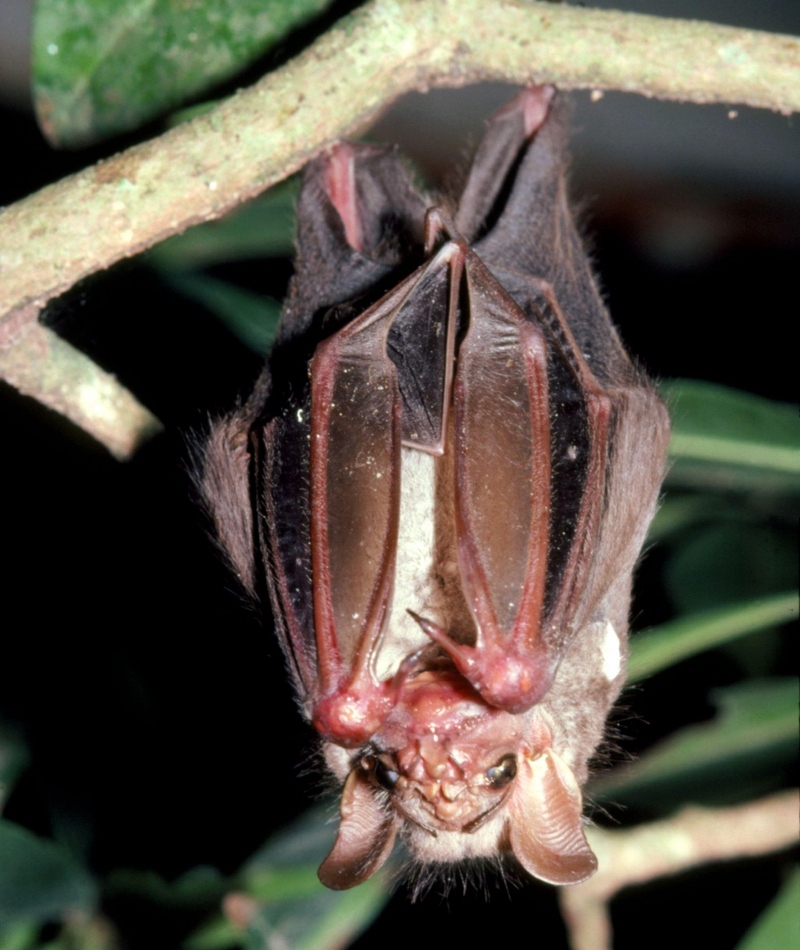
Wrinkle-faced bats mostly eat fruits, although their full dietary range is currently unknown. They secrete a weird odor from their chin to attract their female mates, which is just another quirk that makes them so unique and bizarre at the same time.
Giraffe-necked Weevil
One of the most bizarre bugs of Madagascar can be found in the eastern rainforests. Due to its long neck, it is called a giraffe-necked weevil. At the top of the neck is the head which features two eyes and a pair of antennae that project out from it. Males have a much longer neck than females sometimes by three times as much.

Males have this longer neck for use in combat with other males. The isolation of the island of Madagascar has allowed unique species such as the giraffe weevil to evolve. A similar species is found in New Zealand though.
Labord's Chameleon
Madagascar is home to more than half the world's chameleons including the largest, the two-foot-long Parson's chameleon, and the tiniest, the Pygmy stump-tailed chameleon.

One of the most intriguing, though, is Labord's chameleon which inhabits the dry land in and around Kirindy Forest. What makes this animal remarkable is its 'live fast die young' life cycle of about 4-5 months, shorter than that of any other tetrapod.
Madagascar Leaf-nosed Snake
Snakes of the bizarre genus 'Langaha' are among the island's many impressive endemic creepy-crawlies. In the very distinctive Madagascar spear-nosed snake, males are yellow and tan, with a spear-shaped nasal appendage.

Females look like a different species altogether, greyish in color with a serrated, leaf-shaped nasal extension giving rise to the name 'Madagascar leaf-nosed snake'. Though they are venomous, their poison is not deadly to humans.
Aardvark
The aardvark, which literally translates to earth pig, is a solitary creature that is seldom seen. Still, reminders of their presence exist in abundance as they dig holes throughout the African bush.

The cavities are especially visible around termite mounds, which provide most of the animal’s food. Living up to their translated name, aardvarks do resemble pigs in a way, though their ears are reminiscent of a rabbit's and the tail resembles a kangaroo's.
Pangolin
Pangolins, sometimes known as scaly anteaters, are sometimes mistaken as reptiles due to their scaly appearance, but they are actually scaly-skinned mammals. Its scales are actually made up of keratin, which accounts for about 20 percent of its weight. It has a small head and a long, broad tail. It has no external ears, but its hearing is quite good.

All pangolins are able to roll themselves into a ball in self-defense. When threatened, they can also emit a noxious-smelling acid from their glands. You know, like skunks, except there is no spraying.
Emperor Tamarin
The emperor tamarin is just about as amusing as any creature on our list. For the most part, the emperor is just a typical small-sized, black monkey that enjoys swinging from treetops and eating plants. They use high-pitched, shrill sounds to warn trespassers what their territory is. They also engage in tongue-flicking, rapidly moving their tongue in and out of their mouth to indicate displeasure.

Its giant white curly mustache makes it a dead-ringer for German Emperor Wilhelm II. What was first a comical nickname is now the animal’s official scientific title. The emperor tamarin is native to the rain forests of Peru and Bolivia.
Platypus
The platypus is among nature's most unlikely animals. In fact, the first scientists to examine a specimen believed they were the victims of a hoax. This small amphibious Australian mammal was noted for its odd combination of primitive features and special adaptations, especially the flat, almost comical bill. Early observers thought it was a duck's bill sewn onto the body of a mammal!
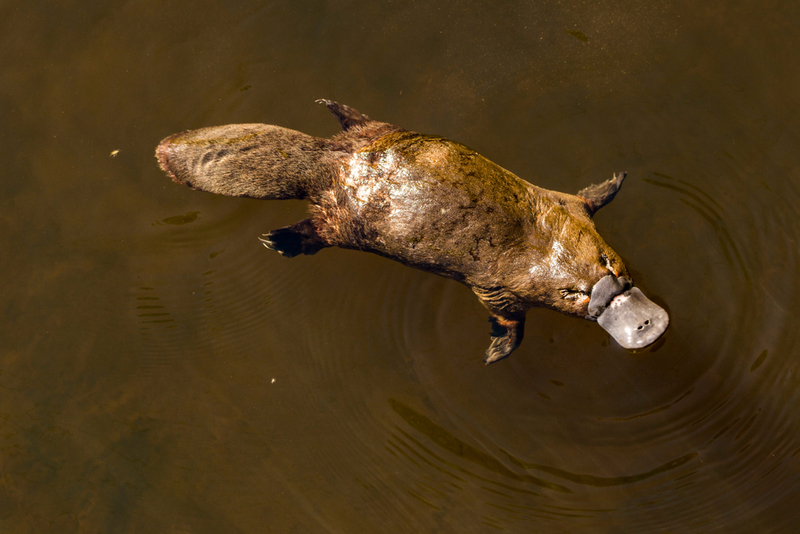
Adding to its distinctive appearance are conspicuous white patches of fur under the eyes. This is one of the only venomous mammal species in the world.
Elephant Shrew
What is this little mouse-like insectivore with an imposing snout? Really, what is this little animal all about? Elephant shrews are uncommonly seen yet distributed all across Southern Africa, in almost every biome.

They are very funny to watch as they sniff out small invertebrates, gathering them with their weird tongue. Despite their name, Elephant shrews are not, in fact, shrews at all. Recent evidence suggests that they are more closely related to a group of African mammals that includes elephants and aardvarks.
Porcupine
A rodent with spikes, that’s how weird the porcupine is. Porcupines are now found all over the world but they have their origins in Africa.

These nocturnal herbivores forage along the ground and are somewhat of a delicacy, especially in parts of East Africa. Those spiky quills are used as a form of defense, helping the porcupine stay off the dinner menu of African cats.
Hercules Beetle
Can we talk about cool bugs now? Because the Hercules beetle is cool. Named after Hercules himself, the Hercules beetle comes into the ring up to 3.3 inches in length. Their massive horns can bring them up to 7 inches.

They’re not just named after Hercules because they look cool, they can reportedly lift something 850 times heavier than their own body weight. That’s like lifting 30 cars for the average person!
Springhare
This weird African animal is an evolved hare species with kangaroo-like hind legs. The vernacular name of this creature is misleading since the springhare is, in fact, a rodent and not a hare. Purely nocturnal, these vegetarian creatures forage at night and retreat to their sandy burrows during the day.
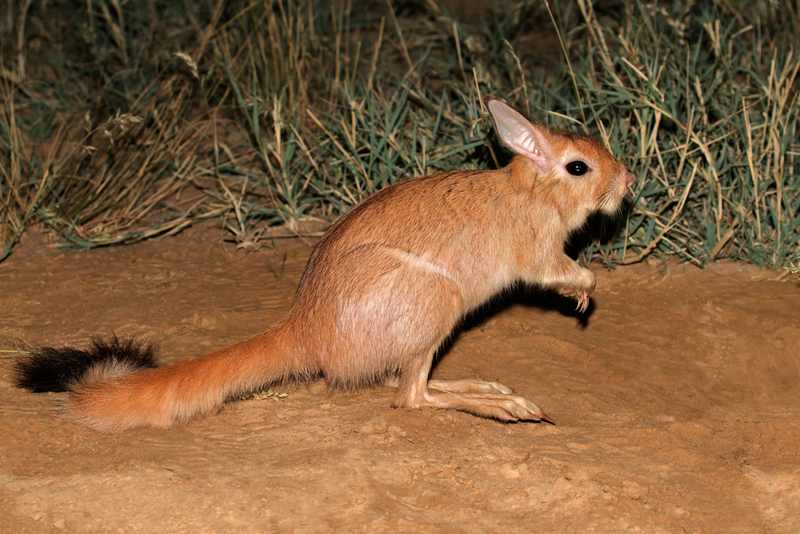
Similar to kangaroos, they are also saltatorial animals who use their tails for balance. Springhares are reported to be able to make hops of 20 cm (7.9 in) and leaps of up to 2 m (6 ft 7 in).
Sloth
These sluggish tree-dwellers are stupefyingly cute and adorably slow. Native to Central and South America, sloths spend the majority of their lives moving through trees in tropical rainforests. They move at a rate of about 40 yards per day, munching on greenery.

Sloths are known for their exceptionally low metabolic rate. Yet surprisingly enough, these long-armed creatures are excellent swimmers. They occasionally drop from their treetop perches into the water for a little swim. Aside from their lack of speed, they always seem to have a permanent grin.
Ostrich
Okay, it’s not that exotic and you’ve probably heard of it, but take a moment to analyze this enormous flightless bird. Ostrich can run at 70 km/h and are highly entertaining when they do so. With their bizarre necks and strange gait, this is one of Africa’s weirdest animals.

Ostrich always appears like they are about to fall over. The way they run is just too funny but their design is perfect. Their long spindly legs mean long strides and their wings help to maintain balance at high speeds.
Red Panda
The red panda looks like a fusion between a panda bear and a raccoon, made instantly recognizable by its red coloring. This arboreal mammal is native to the eastern Himalayas and southwestern China. They are highly territorial and mostly live a solitary existence.

It’s related to raccoons, weasels, and skunks and is slightly larger than an average house cat. Its front set of legs is shorter than the back ones, which gives it its strange waddling walk.
Echidna
Echidnas are both mammals and monotremes, which means they have fur and their young drink milk, but they also lay eggs instead of giving birth to live babies. The eggs incubate in a pouch where they also hatch. Once they hatch, the baby is called a puggle.
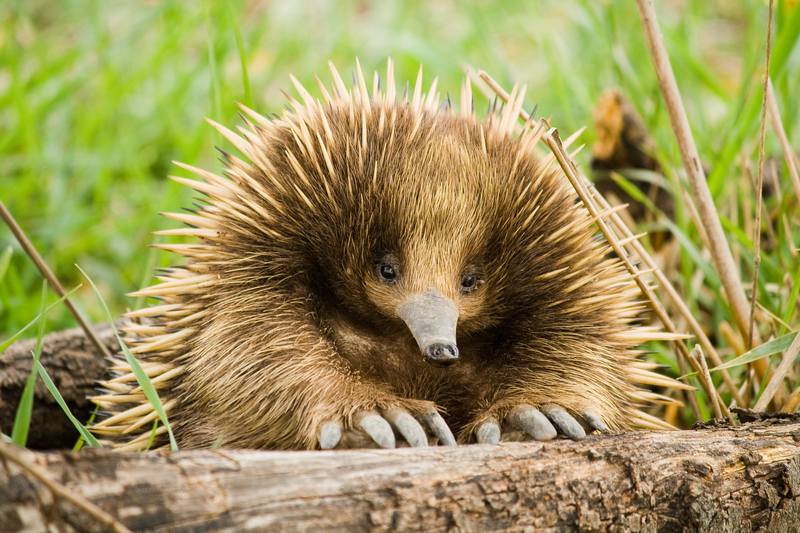
The echidna fur is mixed with spines like a hedgehog. There are three species of long-beaked echidna and all three are only found on the island of New Guinea. This animal's amazing 'beak' has electro-receptors that detect tiny electrical fields produced by the underground worms and insects it eats.
Bat-eared Fox
A strange name and a strange demeanor, but the bat-eared fox is the most efficient hunter on the African savannah. Sure, it looks weird, with those enormous ears, but like all animals, these features have a purpose.

The bat-eared fox has incredible hearing and can even detect prey underground. Once a target is located, the fox burrows in ferociously and chomps onto it. Bat-eared foxes are considered the only truly insectivorous canid, with a marked preference for harvester termites, which can constitute the bulk of its diet.
Tree Kangaroo
We bet you've never heard of Tree kangaroos before! Yes, they are similar to the larger land-dwelling kangaroo, but as you could guess by their name, they spend most of their lives in treetops. Like kangaroos, they have one baby at a time, called a joey, which lives in its mother’s pouch until it can survive on its own.
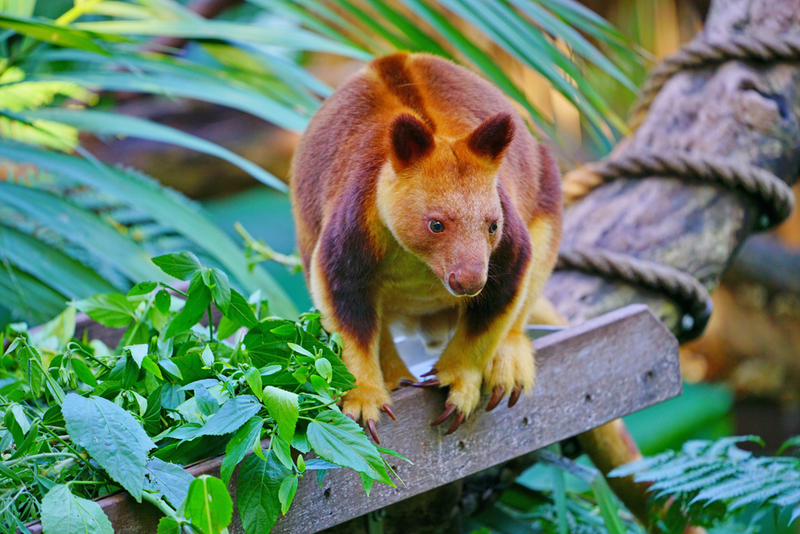
They are also expert jumpers and can jump almost 60 feet down to the ground without being hurt! Although they are omnivores, tree kangaroos prefer to eat leaves and fruit.
Cassowary
They might look like it, but Cassowaries are not dinosaurs. Hpwever, they are one of their closest living relatives. The Cassowary holds the Guinness World Record for being the most dangerous bird. As tall as the average man, cassowaries cannot fly, but they are great swimmers, can jump 7 feet into the air, and run 31 miles an hour.

Native to the tropical forests of New Guinea, Aru Islands, and northeastern Australia, these birds can really defend themselves when they feel threatened. They may leap up and deliver a devastatingly powerful kick that can injure or kill whatever stands in their way.
Southern Crowned Pigeon
Although they don’t look much like our grey pigeon, this beautiful bird is actually the largest pigeon species in the world! Averaging 28 inches long and weighing 5 pounds, these gorgeous pigeons are massive compared to the smaller kinds we see in urban areas.
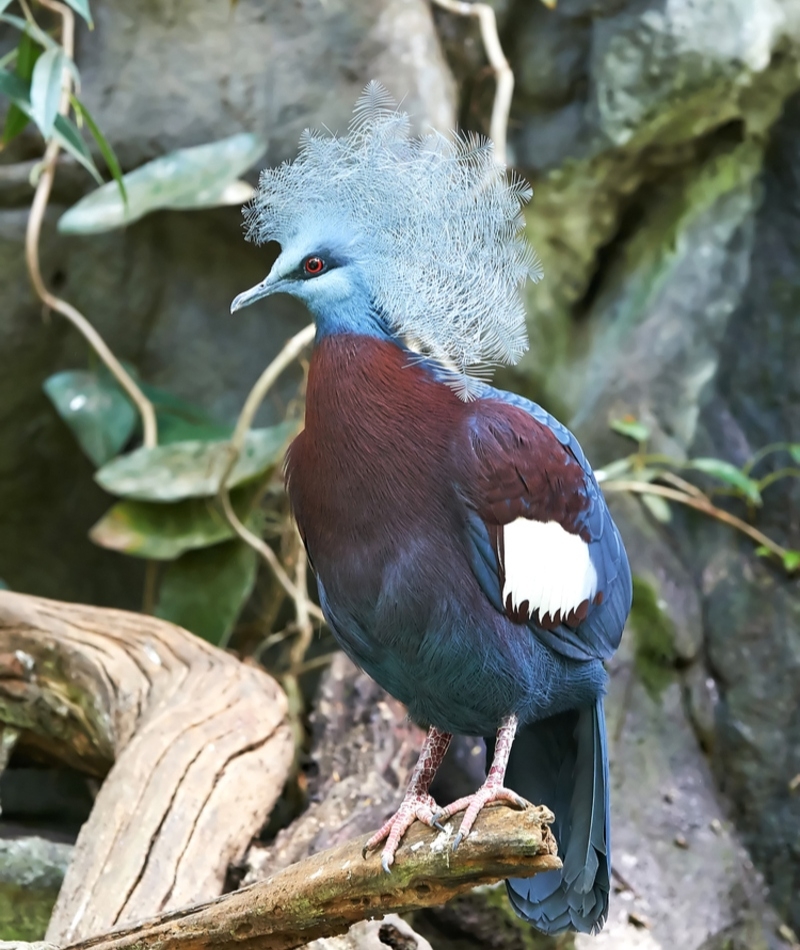
Even in the wild they act very tame and like to eat seeds, berries, and fruit. They are intelligent birds and like to stay in pairs or small groups because they get lonely when separated from the others.
Tapir
Tapirs look like some kind of creature we'd find in a Dr. Seuss book. Standing just over a meter tall, the black and white Malayan tapir has a distinctive, long, flexible nose that it uses as a snorkel when underwater or to grab leaves and fruit off of trees.

Baby Malayan tapirs are born brown with stripes and spots to help camouflage them in the dappled light of their rainforest home. It is one of five species of tapir and the only one native to Asia. Malayan tapirs are found in the tropical forests of Indonesia, Myanmar, and Malaysia.
Venezuelan Poodle Moth
This fluffy little insect was discovered in Venezuela only as recently in 2009, this new species has still not been properly studied, so there is not much we know about them. They tend to grow to about 1 inch or around 2,5 cm in size.
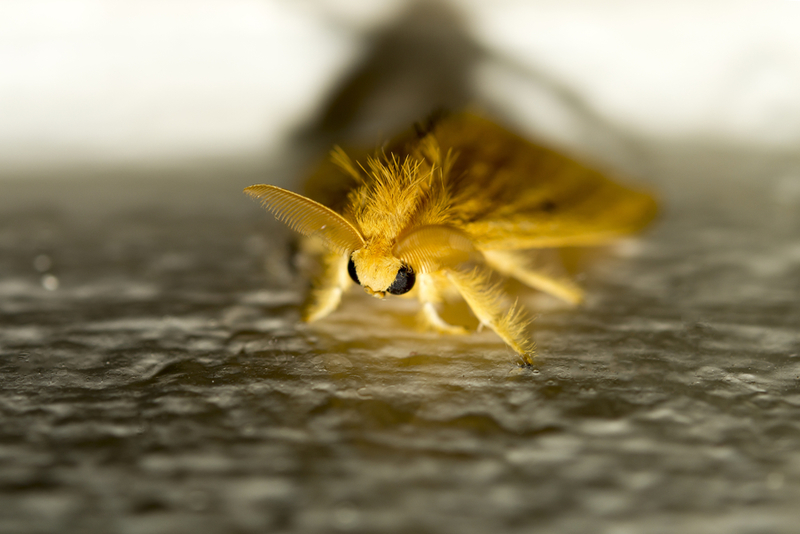
This alien-looking moth has big bulging eyes, spiky antennas, and poofy-like fur covering its head, thorax, abdomen, and even wings.
Amazon Giant Fishing Spider
Places like the Amazon are home to some of the most beautiful, unique, and captivating creatures on Earth. Unfortunately, they are also home to some of the most dangerous and scary ones too. This harsh and moist environment has led to some extreme mutations, but almost none of them compare to the giant fishing spider.
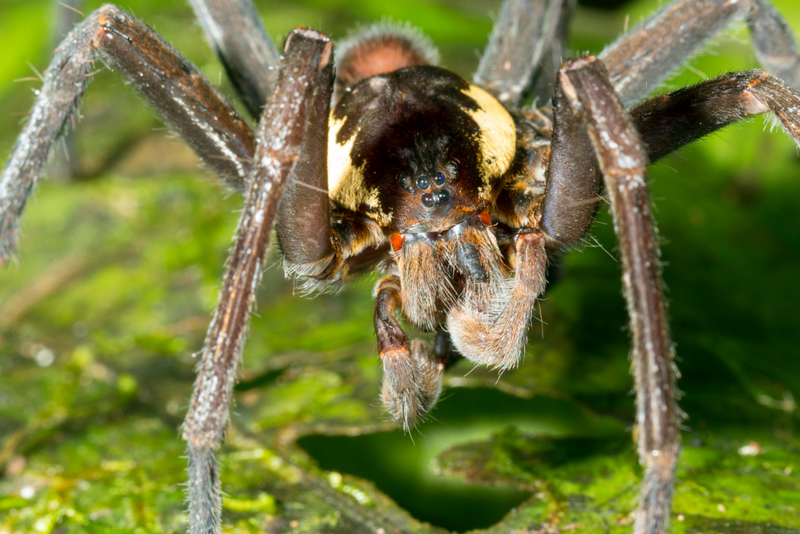
This creature tends to grow up to eight inches in length and is an excellent fisherman. The Amazon giant fishing spider loves to camp on the water's surface before taking a swing through the underwater sea life and having his dinner. If you ever find yourself in the Amazon, we recommend staying as far away as possible from this terrifying hybrid.
Hairy Frog
When the number one search result for hairy frogs is asking whether these things are real or a joke, you know that you're dealing with a true mystery of nature. These incredibly bizarre frogs mostly come from Central Africa and are also known as Horror frogs and Wolverine frogs.
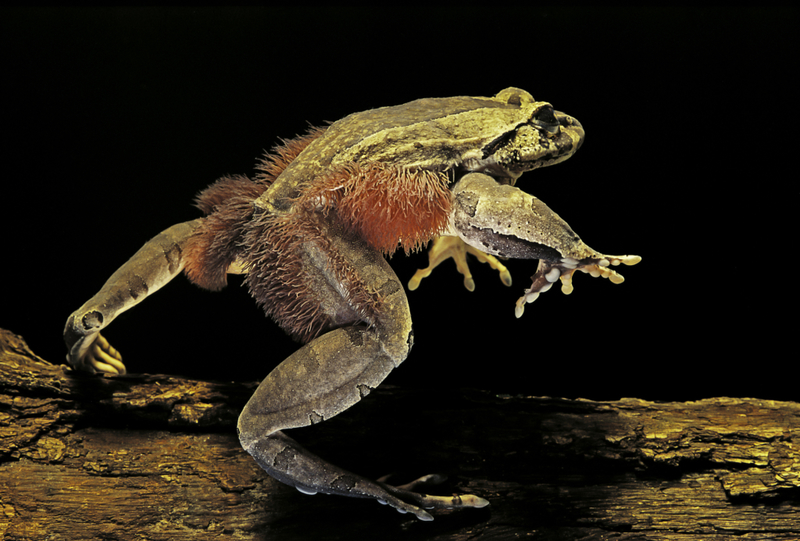
Their name is in reference to the unique hair-like structures on their hind legs and sides, which are believed to increase their oxygen absorption abilities. If that's not weird enough, Wolverine frogs also have sharp claws in their back feet, which they create by breaking their bones. Scientists believe these are used during combat, but this has not been proven to date.
Remora
The remora fish can be most easily recognized by its head, which looks like a tractor went over it and left a flat tread. This head feature is actually a sucking organ, which allows it to attach itself to larger sea creatures. The remora's ability to piggyback and ride on fellow sea dwellers is what gave it the nickname "The Suckerfish".

It sometimes accidentally attaches itself to boats and even divers, which usually leads to some pretty funny photographs. The remora's attachment ability puts it on the verge of being called a parasite, but honestly, it doesn't harm its host in any way, and might even give it a good cleaning on the journey to its destination.
Portuguese Man O' War
The Portuguese man o' war is one of the weirdest marine creatures to have ever been discovered. It has long, venomous tentacles that are capable of killing not just large fish, but also humans. Its name comes from the "man-of-war", an 18th-century sailing ship that resembled the creature when it was set to full sail.

You can find these creatures on the surface of the ocean in the Atlantic, Indian and Pacific oceans. This is one creature you want to avoid like the plague, as it could provide quite a painful ending to your aquatic journey. If you're ever swimming around the shores of Florida, make sure to watch out for any sea life resembling the alien from the movie "Life".
Hammer-Headed Bat
The hammer-headed bat is both weirder and more normal than it looks in the picture below. It's basically a bat with the head of a moose. It has an extremely strong jaw and is the largest bat in Africa. It's known to grow up to 450 grams in weight and can reach a total wingspan of around three feet.
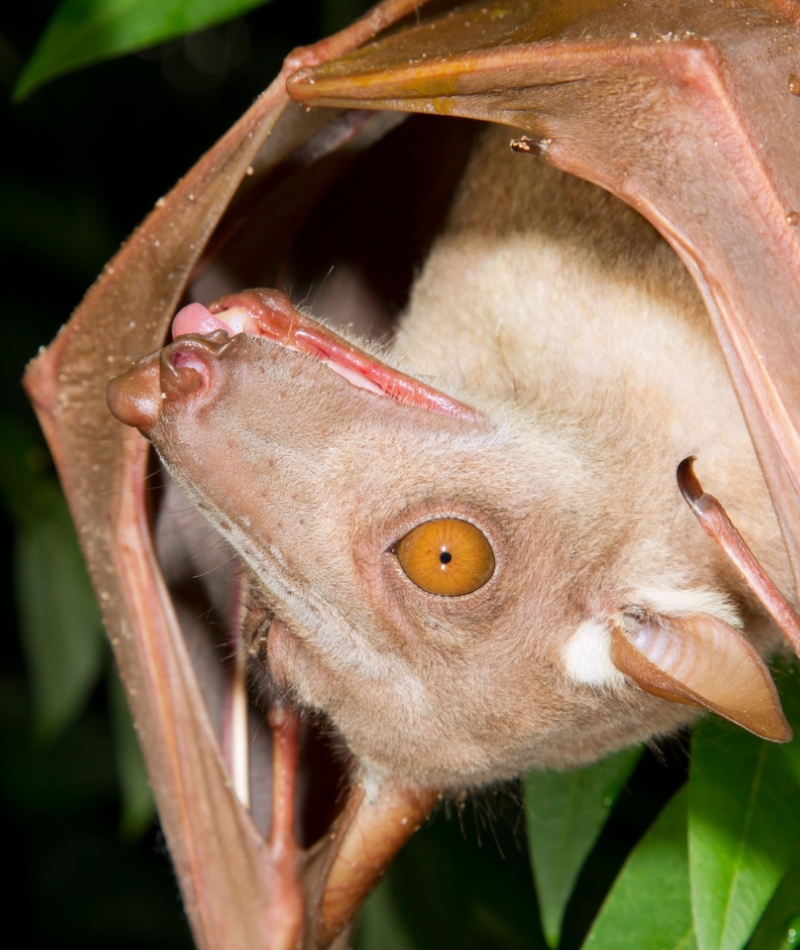
Believe it or not, but the purpose of the hammer-headed bat's large jaw is actually to attract females. It uses its enormous head to produce loud mating calls and also tends to attract females with its oversized jaw. While various rumors and scientific myths have assumed that these bats are carriers of the Ebola virus, no evidence has been gathered so far to confirm this suspicion.
Purple Frog
The purple frog, also known as the pig-nosed frog, is definitely one of the weirder frog species out there. It lives mostly in the Western Ghats in India and can be found underground or on the surface during mating season. The purple frog appears extremely bloated and has tiny arms and legs when compared to its large body.

These poor frogs are often hunted and turned into amulets, which has caused them to become endangered in India. Unlike most frogs, their massive bodies prevent them from jumping or moving around quickly. Purple frogs make clucking noises that are very similar to regular frogs, although they could not be further apart visually.
Guianan Cock-of-the-rock
If you manage to get past its incredibly confusing look, you'll find that the Guianan cock-of-the-rock is one of the most pristine and beautiful birds to be found in nature. It can be traced to various tropical rainforests and sports a beautiful bright orange color. This bird mostly eats fruits and has been known to feed primarily off canopy trees and lianas.

The male Guianan cock-of-the-rock uses its incredible colors and crest to attract female birds and tends to breed early in the year. Despite being relatively safe and unthreatened in terms of extinction, this bird species is protected and bred by various organizations. It is mostly eaten by jaguars and other large cats but usually manages to stay safe from predators.
Bigfin Squid
On the list of deep-sea creatures you never want to come across, the bigfin squid is a great competitor for first place. This creature is genuinely one of the most terrifying things that lurk in the ocean and resembles something straight out of an H. P. Lovecraft novel. It's an extremely rare cephalopod, and is known mostly as the "long-arm squid".
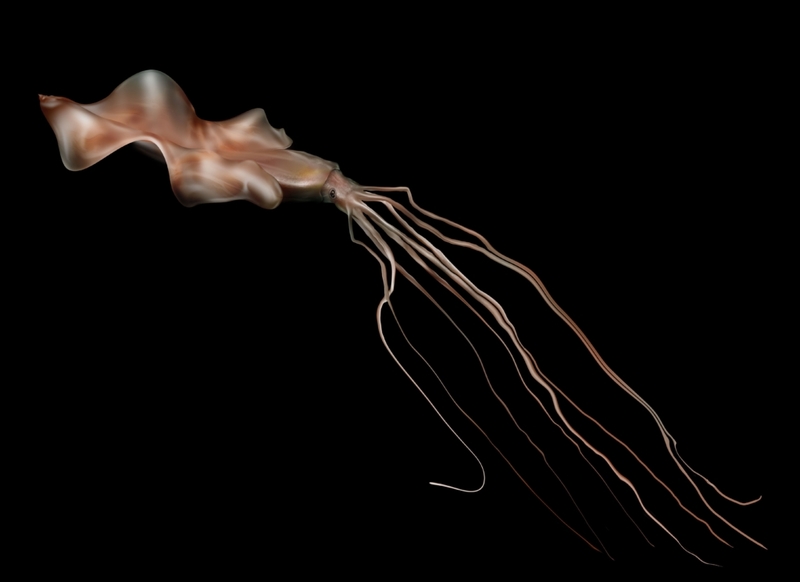
Due to its rarity, it's not yet known if the bigfin squid is just a mutated creature or a full-blown category of species. Although there is no consensus among scientists on their official proportions, it's believed that these sea creatures are many times longer than your average adult male. While it may be harmless to your body, this big-fin squid definitely has the ability to damage your mental health.
Helmeted Hornbill
Don't worry, this bird didn't get a big boom-boom on his head, it's actually just one of its unique features. The Helmeted Hornbill can be found mostly in the Malay Peninsula and is widely known for this exotic bulge that sits on the top of its beak. Experts claim that this casque accounts for about 10% of the bird's weight.
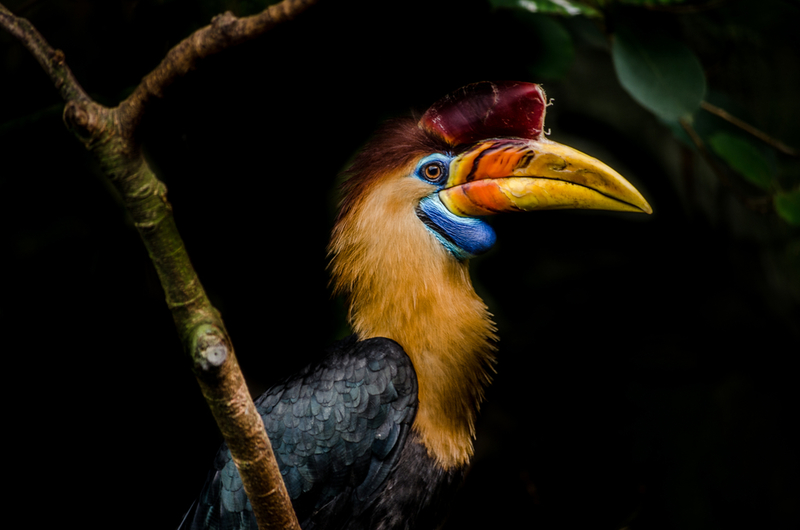
Unfortunately, the Helmeted Hornbill's special casque also makes it a target for hunters and poachers, who managed to turn it into a critically endangered species. The locals use this unique feature and turn it into art and jewelry, while others view it as a spiritual talisman. There have been tens of thousands of these birds killed annually. Hopefully, the trend will end soon, before it's too late.
Lowland Streaked Tenrec
Many people claim that the lowland streaked tenrec is the horrible result of what Pikachu from Pokemon would look like in real life. This unique rodent can be found in Madagascar and is mostly known for having long and sharp hair-like bristles that resemble that of a hedgehog. The lowland streaked tenrec has built up various mutations and adaptations over the millenniums, as it evolved to survive in the Madagascan rainforests.

There are currently 37 officially discovered species of the tenrec on the island of Madagascar. If you ever come across one of these, it would be best to leave it alone. Their bite is quite painful, and you don't want to get stabbed by their extremely sharp spikes.
Red-Lipped Batfish
An easy way to describe the red-lipped batfish is by thinking of your oldest living cousin who wears too much makeup and combining that with, well, a fish. This hilarious sea creature can be found mostly around the Galapagos Islands off Peru and tends to stay in depths of up to 250 feet. It's mostly known by the obvious bright red lips on its face, and also for being a terrible swimmer.

Red-lipped batfish live off of small fish and invertebrates, including shrimp, crabs, worms, and mollusks. They are quite harmless to humans and spend most of their time staring hilariously into the abyss. Scientists believe that their large forehead is actually a feature that attracts prey.
Star-Nosed Mole
The star-nosed mole is another addition to the nightmarish animals found on this list, and might as-well originate from the 1982 horror film, "The Thing." The Star-nosed mole is basically a hamster-sized mole that has all the normal bells and whistles of this digging species. What makes it so unique and terrifying, is its incredibly bizarre nose, which contains over 25,000 sensors that can discover seismic activity.

Despite being completely blind, the star-nosed mole has very adapted sense abilities, thanks to its star-shaped nose. It can collect about five times more data than a human hand, and is known for being one of the world's fastest eaters. It might be gross, but you can't deny that this mole is extremely capable.
Japanese Spider Crab
For the first nightmare-fueling creature on this list, we present to you the Japanese spider crab. This massive creature's legs can reach up to 12 feet and can weigh up to 42 pounds as an adult. You can find them in the deep, dark depths of the ocean, usually from 500 feet below the surface.

Japanese spider crabs were discovered in 1836, and are notoriously hard to catch. Still, many citizens love using them as food and often cook them — when they can catch them, for their crab meat. They can live up to 100 years and will eat just about anything from fish to plants. Despite their terrifying look, they are fairly gentle as long as they don't feel threatened.
Blue Dragon (Glaucus Atlanticus)
Glaucus Atlanticus, also known as The Blue Angel or The Blue Dragon, is a small sea slug with an incredibly exotic look. It's a tiny creature and only reaches about 1.2 inches in length. They are quite rare, and can mostly be found in a few special places in India. The Glaucus Atlanticus tends to feed on small open sea creatures, and hunts them using his venomous sting.

If you ever find one that got carried to the shore on a beach, make sure to avoid touching it. These slugs store poison they get from the jellyfish they eat, which makes touching them highly painful and potentially dangerous. Simply admiring them from a distance works great, as these are truly beautiful and artistically inspiring creatures.
African Clawed Frog
The African clawed frog is a unique species of frogs, mostly due to the three smooth, short claws it has on each hind foot. It uses these claws to tear apart its food, which is quite useful when you can't use a fork and knife. You can find them in Sub-Saharan Africa, specifically Nigeria and Sudan, where they spend most of their time in ponds and rivers.
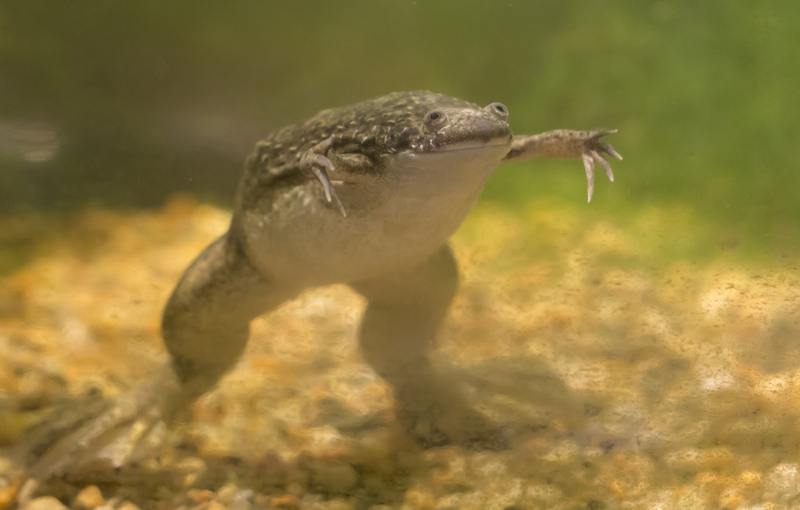
It's believed that the African clawed frogs have no tongues, no teeth, and no ears. Despite the lack of these sensory organs, they have fantastic senses and can even detect movements and vibrations in the water. These frogs will eat just about anything small enough, whether its living or dead, as they are one of the least picky eaters on earth.
Hoatzin
The Hoatzin is one of the weirder birds on our list and managed to accumulate a respectable list of nicknames, including the reptile bird, the skunk bird, and even the stinkbird. This bird reaches up to 26 inches in length and has a unique feather structure on its head that makes it look like a teenager on a first date.
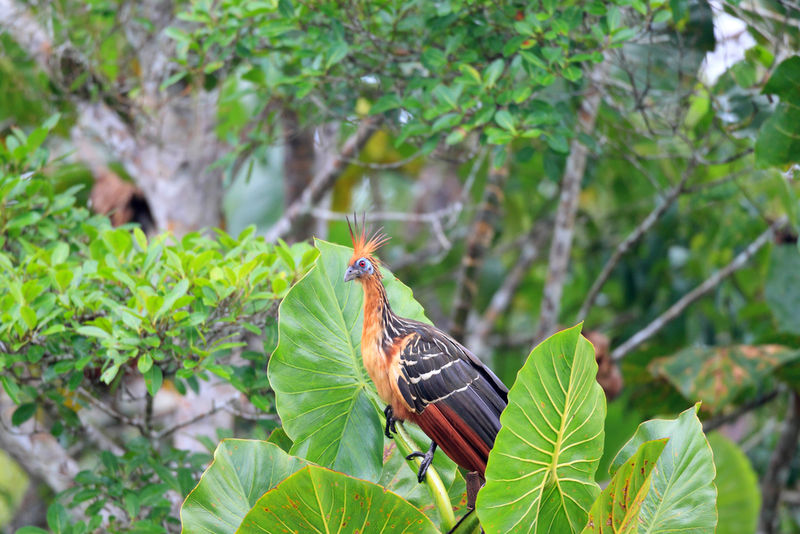
Its mohawk is actually a defensive mechanism and helps it scare away predators, probably by implying that its head is spiky and dangerous. Scientists don't know a lot about the origin or evolution of this bird, but we have sent a recommendation to classify it as the world's first heavy-metal bird species.
Vogelkop Superb Bird-of-Paradise
Male birds go a long way in order to guarantee their chances of mating with females of their kind. Some of these birds will learn how to sing, while others grow a very eccentric kind of feathers. The Vogelkop superb bird-of-paradise also does his best to impress the ladies, by turning into a weird alien creature with mesmerizing blue eyes.
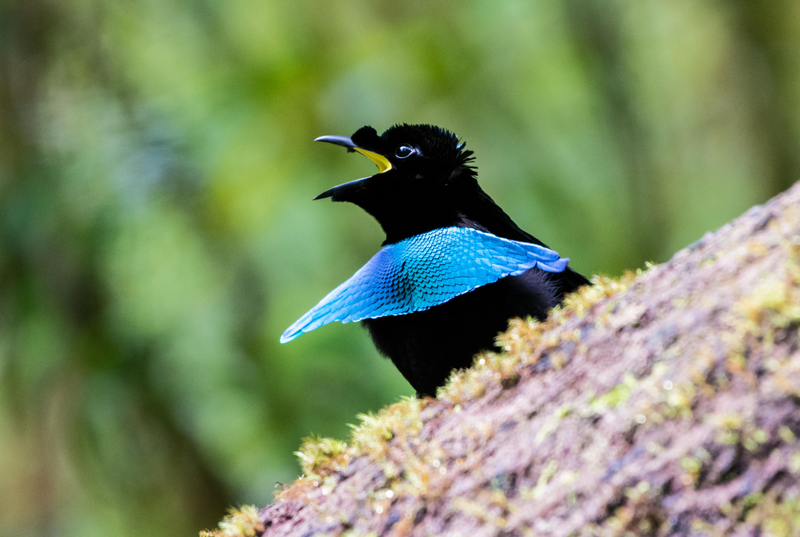
This bird is equipped with black and blue feathers which he extends in order to create an arch shape when he wants to attract a mate. When it wishes to do so, it will dance around a female and face her with his pitch-black side. We're not sure how this is attractive to the female bird, but eh, to each his own.
Axolotl
You may have seen the Axolotl before in a popular internet meme or two. If you've ever wondered what this creature is, it is a salamander, otherwise known as The Mexican Walking Fish. Despite its name, it is an amphibian rather than a fish. It was originally discovered in lakes surrounding Mexico City.

Unfortunately, over the past decade, these rare creatures reached a state of being at critical risk of extinction, as they were being sold as food. The Axolotl has a unique ability to regenerate limbs, which makes them primary targets for research by scientists who want to develop the same ability in humans.
Sri Lanka Frogmouth
One of the more exotic and beautiful birds on our list is the Sri Lankan frogmouth, a bird with an extremely unique and beautiful head. It tends to resemble an owl more than a frog, but often appears to be smiling due to the curvature of its beak. You can find this species in South India, among many other unique birds and animals.

It's one of the more captivating birds to look at, and we highly recommend looking out for them if you ever find yourself in an Indian forest. One of the most distinctive features of the Sri Lanka frogmouth is its unique mating call, which can typically be heard from dusk until dawn.
Mexican Mole Lizard
Meet the Mexican mole lizard. This long, bizarre, and legless lizard has small T-Rex arms and is one of the only four amphisbaenians in the world that actually has legs. It can be found in Baja California, right on the border of the state of California, and tends to be out in the open during midsummers. They might be a creepy sight to behold, but they aren't dangerous in any way.

The Mexican mole lizard mostly eats ants, termites, underground insects, and worms. Highly suited for the deserts, it likes to hunt during the day and sleep underground during the night. Like many lizards, one of its main escape tactics is to shed and later regrow its skin. Mexican mole lizards are fairly long and can reach up to 9.4 inches in length.
Aye-aye
Aye-ayes are one of the weirdest looking primates on earth. These unique lemurs are mostly found at night in the Madagascar rainforest trees, as they search for food and shelter. Despite looking like chipmunks on Ritalin, they are actually quite intelligent and can use their human-like opposable thumbs to hang from tree branches.

Locals in Madagascar tend to stay away from the Aye-ayes because, for them, these mammals are like black cats. They are the world's largest nocturnal primate and are unfortunately considered endangered at the moment. This is due to unnecessary killing and environmental destruction, which forced the government to write laws protecting their lives and habitat.
Ocean Sunfish
Some fish have a tendency to carry around a surprised look on their faces, which is always a hilarious sight to see. Almost none of them, however, look as surprised or are as convincing as the ocean sunfish. This massive sea-dweller weighs up to 5,000 pounds and can reach a size of up to 14 feet long and 10 feet high.

These fish love staying close to the surface and enjoying a good suntan, which is partly why they're called sunfish. Smaller fish tend to gather around them and eat parasites off their skin, which is a great win-win situation for the ocean sunfish and its guests.
Heikegani Crab
We've already established that some of the weirdest crabs tend to hail from Japan, and the Heikegani is no exception. This crab is known for its shell, which tends to resemble a human face, often being compared to that of an angry samurai. This feature gave the Heikegani a nickname many centuries ago which still follows it to this day — the Samurai Ghost Crab.
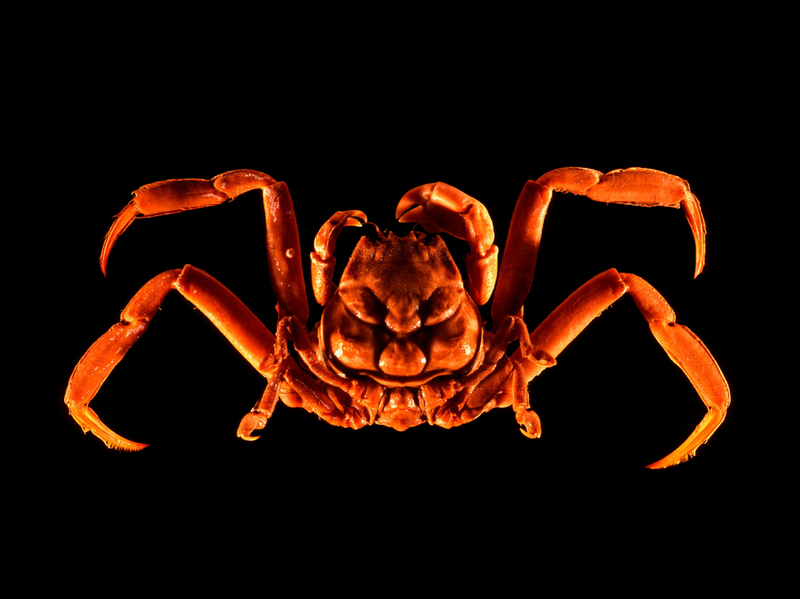
Japanese culture puts these creatures on a pedestal, as it believes that they are the reincarnated Heike warriors, who were defeated in 1185 at the Battle of Dan-no-Ura, as told in The Tale of the Heike. Heikegani crabs are a popular example of how people tend to find meaning and resemblances to humans when they look at various shapes in nature.
Stargazer Fish
The stargazer fish can be instantly recognized for having one of the most dissatisfied expressions ever seen on a living creature. This grumpy sea creature has often been cited as "The Meanest Thing In Creation", which is evidently clear when you stare at it for even one second.

The stargazer fish features incredibly large eyes on the top of its head and comically buries itself on the ocean floor until it finds prey to suck into its mouth. This creature is actually a very good hunter, and sports various tricks up its sleeve from two venomous spines and up to literally being able to electrically shock anyone who touches it, so do yourself a favor and admire from afar.
Pink Fairy Armadillo
Some people say that Armadillos are extremely adorable, while others think of them as rats with armor. Either way, the pink fairy armadillo is probably one of the cuter versions of the species, and only grows up to 5 inches long. This little guy likes to live underground and uses a little biological trick to keep itself warm.

The pink fairy armadillo pumps blood into its armor, which is one of the reasons why it looks strangely skin-colored. These little creatures can be found in the deserts of Argentina, but are usually quite hard to come by and even harder to catch, as they spend their days underground.
Greater Sage-Grouse
The greater sage-grouse is a unique bird found in western North America. It got its name from having large, white, beard-like feathers and a general exotic appearance of wisdom. The bird uses its two large air sacs to attract females, by inflating them and making weird popping sounds.

The greater sage-grouse is the largest grouse in America and tends to stay in one area without doing too much traveling. There are about 1,700 adult greater sage-grouses left in the United States. This bird has lost much of its population in recent decades due to habitat loss and is currently under threatened or near-threatened status according to various organizations.
Wrinkle-Faced Bat
One of the most bizarre-looking species of bats that can be found in Central America is the wrinkle-faced bat. It mostly looks like a regular bat, except that it also has a very wrinkled face. These can be found in various Central American forests from Belize to Colombia, Costa Rica, and other locations.

Wrinkle-faced bats mostly eat fruits, although their full dietary range is currently unknown. They secrete a weird odor from their chin to attract their female mates, which is just another quirk that makes them so unique and bizarre at the same time.
Eastern Long-Necked Turtle
The eastern long-necked turtle almost looks like something straight out of a mythological story. For the most part, it's a regular turtle, except that its long neck and incredibly alluring eyes make it look like a hybrid between a snake and a turtle. It's able to bend its neck in various angles and is speculated as being able to bend and look 180 degrees backward.

You can mostly find these in east Australia, although they have also been imported to various other countries. These reptiles are generally black in color and eat mostly insects and small animals. They are able to emit a foul-smelling fluid from their musk glands when threatened, which gave them the nickname of "stinkers".
Spike-nosed Tree Frog
The spike-nosed tree frog, also unofficially known as the Pinocchio frog, often looks like a frog with the face of a mosquito. It can be found mostly in the Foja Mountains of Indonesia and proved to be a massive shock to the biologists who found it.

These frogs were discovered back in 2008, but there is still much we don't know about them. Their unusually long noses can inflate and deflate when calling, much like other frog species and the skin pocket on their lower jaw.
Indian Gharial
The Indian gharial is a unique crocodile that looks a lot more like a duck than an alligator. It reaches up to 20 feet in length and is mostly recognized by its unique snout, which makes it look like it might quack at any moment. This ancient beast is believed to have evolved more than 40 million years ago but is currently in critically endangered condition.
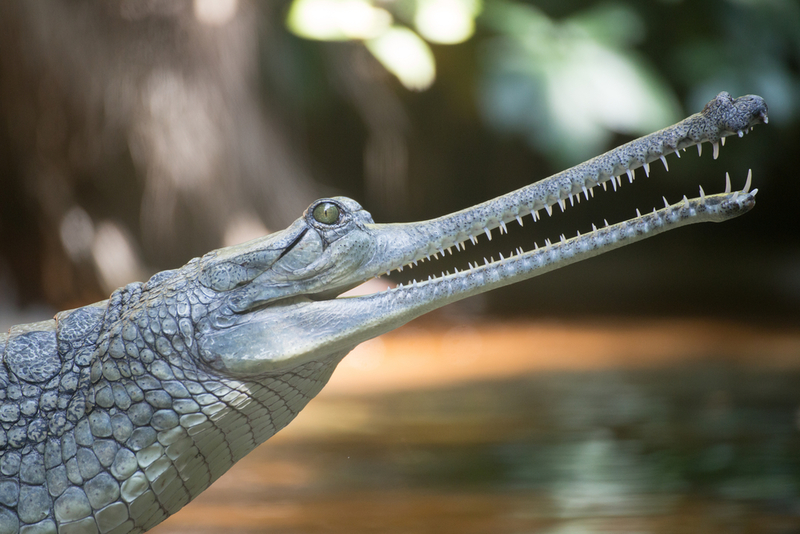
While we're poking a bit of fun at its appearance, it's important to note that this crocodile can easily hunt and kill a human if it really wants to. You can find these carnivores mostly around the northern Indian subcontinent. Its main reason for being near extinction is a loss of habitat and food supply, and humans are rushing to fix this before it goes fully extinct.
Silkie Chicken
Silkie chickens are like the ultimate combination of chickens and dogs. They are fluffy, furry, and friendly birds that could easily work as pets. Despite being covered almost entirely in a white fur-like coating, silkie chickens actually have either black or dark-blue skin. Breeders have managed to make these birds grow various different colors of plumage just for fun.
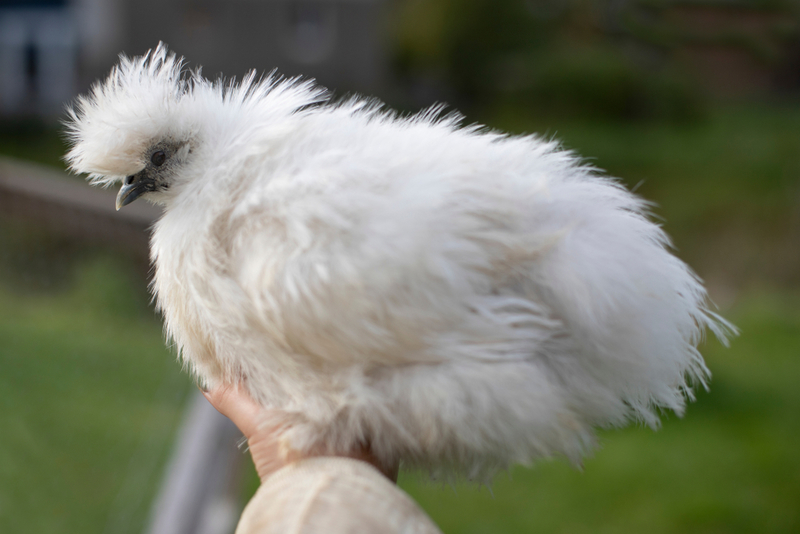
These beautiful birds originate from Asia, particularly China, and were referenced by the iconic Marco Polo sometime during the 13th century. Silkie chickens are known for being very calm and tempered. If you're looking for a bird as your next pet, these Chinese beauties are a great potential friend.
Marabou Stork
When parents tell their children how babies are delivered by storks in a neat and comfortable blanket, we have a hard time believing they have the marabou stork in mind. This bizarre creature sports a massive appendage on its throat, which makes it seem like it has a really bad case of inflammation.
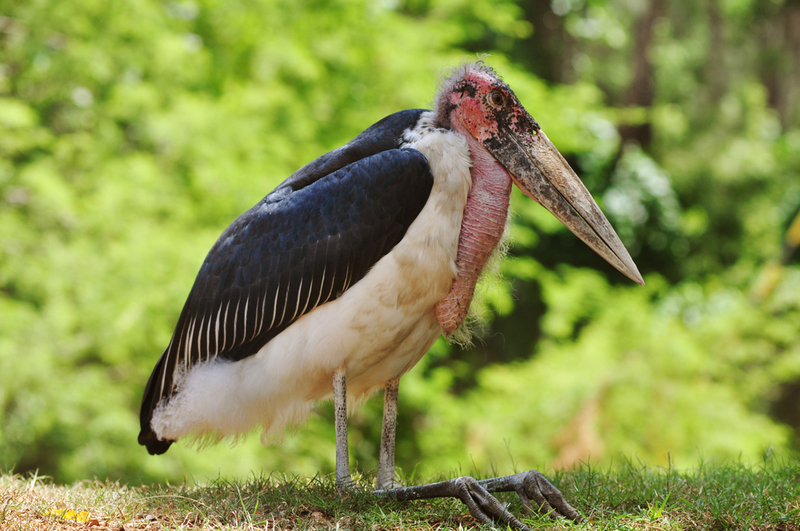
These storks can be found in the areas of Africa south of the Sahara. Their name is derived from the Arabic word 'murabit', which signifies quiet and hermit-like behavior. They are quite large birds and can reach up to 5 foot three inches in height, and weigh up to 20 pounds. You should probably avoid the urge to give them inflammation relief medication, as they are quite unfavorable to humans.
Proboscis Monkey
Let's face it, the only reason anyone knows what a Proboscis monkey is can be easily traced to its incredibly large and funny-looking nose. These monkeys can mostly be found in Indonesia, and belong to the subfamily Colobinae of the Old World monkeys. They are one of the largest monkey species in Asia and can weigh up to 50 pounds.
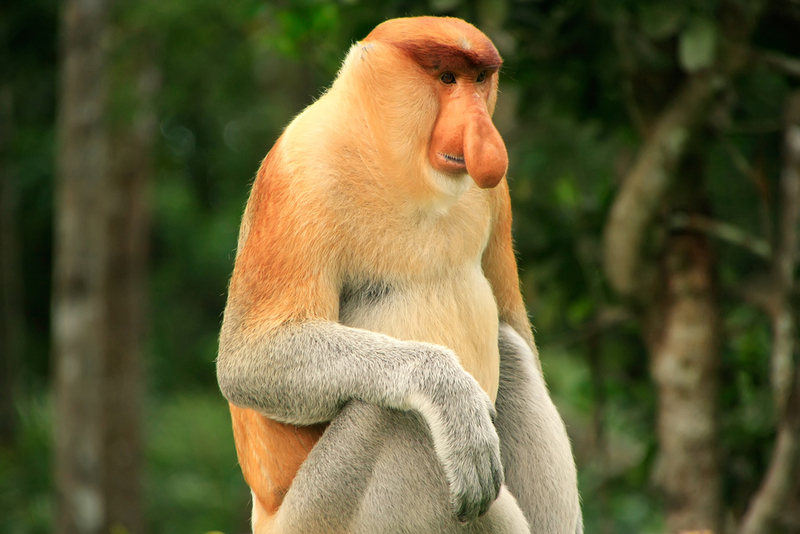
Scientists have speculated that the male's large nose is a feature made for sexual selection, as it holds no practical benefit other than being hilarious to humans. Proboscis monkeys are known for being fantastic swimmers and have webbed feet to be able to quickly escape from crocodiles.
Matamata Turtle
The mata mata turtle is often referred to as the weirdest turtle on earth. It has one of the most bizarre heads of any animal and originates from deep in the Amazonian forests. These turtles are quite big and can reach up to two feet in length. Matamata turtles are also known for having relatively long lifespans and can live up to 75 years.

Matamata turtles have a voracious appetite for fish and tend to wait for food to come to them, rather than actively hunting for it. When a small sea creature gets close enough to the mata mata turtle, it simply opens its mouth, sucks it in, and bites down on it quickly, ensuring a fantastic meal.
Ankole-Watusi Bull
You may be wondering if the Ankole-Watusi is a real thing or just the result of some really good Photoshopping. This large-horned bull is actually an American creation and is the result of breeding the cattle with the largest horns until they reached this monstrous size. While the Ankole-Watusi has various colors and patterns on its skin, what makes it unique is the massive horns it packs on its head.
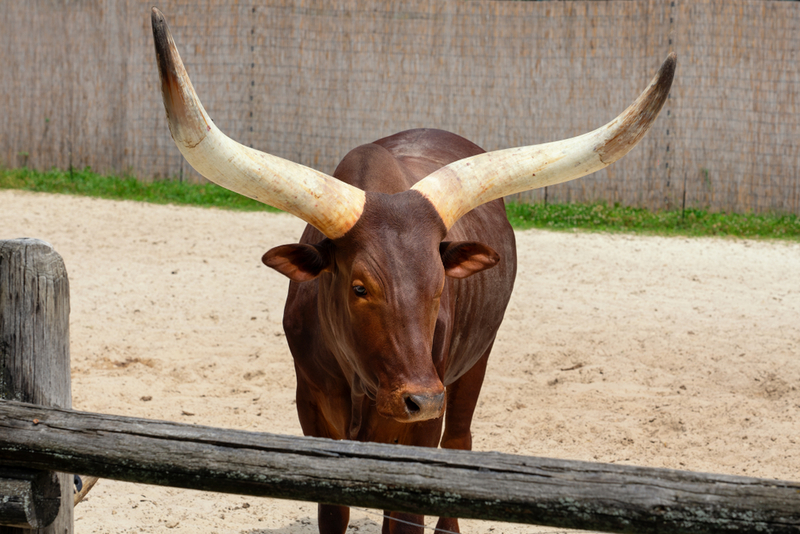
These horns are the largest in the world, and one such Ankole-Watusi holds the Guinness World Record for the horns with the largest circumference in the world (at 40.7 inches long). Many of these animals are used privately by farmers for various purposes. Despite being a relatively calm animal, this is one creature that you don't want to get on the bad side of.
Achatina Fulica
Achatina Fulica, also known as the African giant snail, is often considered the largest and most invasive type of snail on earth. It thrives in areas with large climates and eats crops and vegetation at unbelievable rates. This massive snail can reach up to 2.8 inches in height, and 7.9 inches or more in length.

The Achatina Fulica loves feeding off vegetation, and could easily wipe out a large swath of crops if left unnoticed. Humans have used the giant African land snail as everything from a delicacy, to literal pets, especially in France and the UK. These snails are hermaphrodites, meaning that they have both male and female reproductive body parts.
Saiga Antelope
The next animal on our list looks like something straight out of a sci-fi adventure film — the critically endangered saiga antelope. This four-legged beast hails from the foothills of the Carpathian Mountains and Mongolia. It has been hunted quite excessively over the centuries, especially in Romania and Moldova, and eventually became completely extinct in these areas.
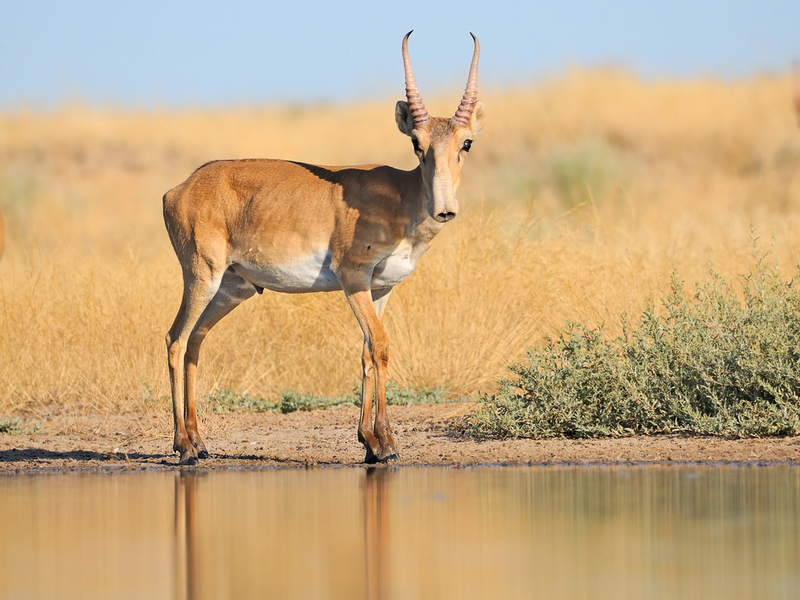
The saiga antelope has had a very bad string of misfortune in the past few decades, including the death of over 200,000 of these in just 10 days. This mass death happened just a few years ago and is believed to have happened due to a shared infection. They are currently on the brink of extinction, and the odds of recovery depend on strong preservation efforts.
Casper Octopus
The ghost octopus is one of the more recent deep-sea discoveries made by scientists. It was found near the Hawaiian Island deep in the pacific ocean, and has gripped the internet to the point of being called "Casper".
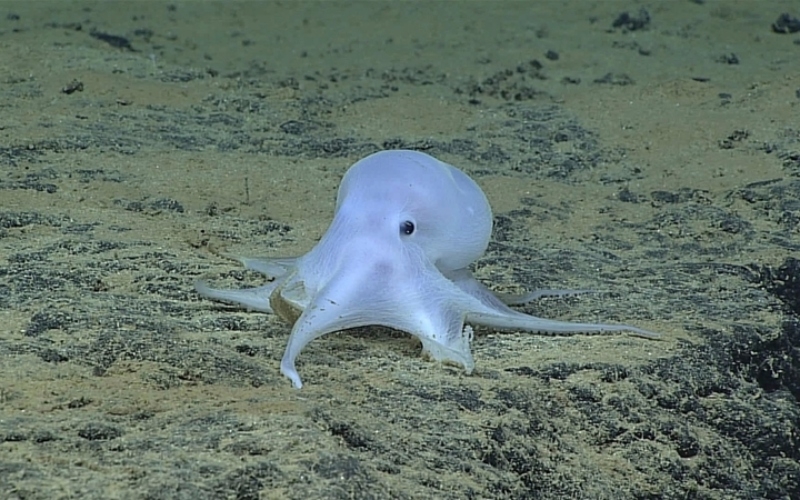
This little guy likes to lay up to 30 eggs on a bed of dead sea sponges and then proceeds to nest on these eggs for years. At this point, Casper is more an internet and biology fad than an actual new species. It remains to be seen whether or not more of these will be discovered.
Tarsier
You may have seen the tarsier appear in various internet memes, pictures, and videos over the years, but in case you haven't learned about this primate yet, here's the short story behind it. The tarsier can mostly be found in Southeast Asia, particularly in the Philippines, Malaysia, Indonesia, and Brunei. It's known for having extremely large eyes and a very unique body structure, which gives it an almost alien look.

Many people compare the tarsier to Gollum from "The Lord of the Rings" series, an association which we strongly agree with. The tarsier helps out farmers by living on a purely insectoid-based diet and is an excellent addition to the workforce when it comes to getting rid of agricultural pests. It's also very cute.
Ctenophora
Despite looking like a combination between a jellyfish and an alien, the ctenophora, which is also known as a comb jelly, is a distant cousin of the jellyfish. It's an underwater predator and often eats anything from microscopic larvae to small crustaceans. The ctenophora actually goes back hundreds of millions of years ago and is considered one of the oldest living creatures on planet earth.
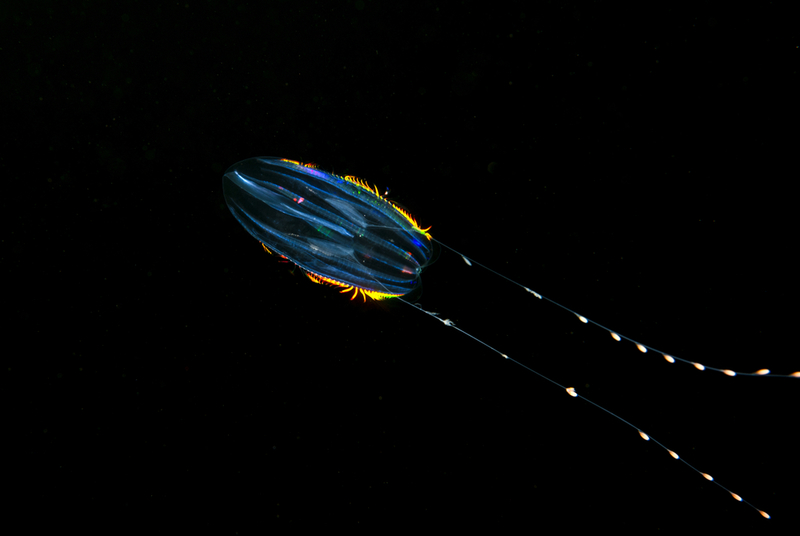
This sea creature is combined of eight comb rows which it uses for swimming. It has no brain or central nervous system, but can still use its nerve ends to find and capture prey. While it's not the weirdest aquatic creature on this list, it's definitely one of the most visually interesting.
Dumbo Octopus
The adorable Dumbo octopus is an umbrella octopus and they are found all around the world. Their name comes from Disney's "Dumbo" because the creature's ears bear similarity to the movie's title character.
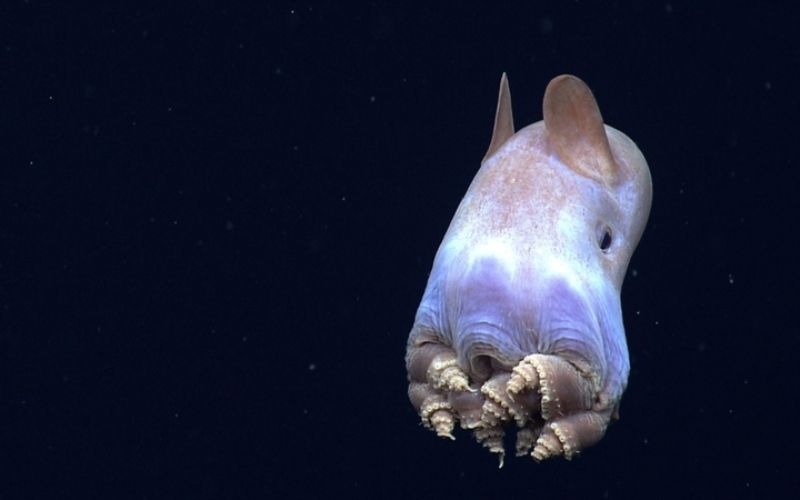
These creatures swim by flapping their "ears" or propelling water through their funnel, somewhat like a squid. These guys are surprisingly fast and can easily evade predators through their small size and ability to hide away.
Macropinna Microstoma
This species of fish lives at a depth of about 600 meters to 800 meters, and can often be found hanging almost motionless in the water. They use their ultra-sensitive tubular eyes to search for distant silhouettes of prey overhead.
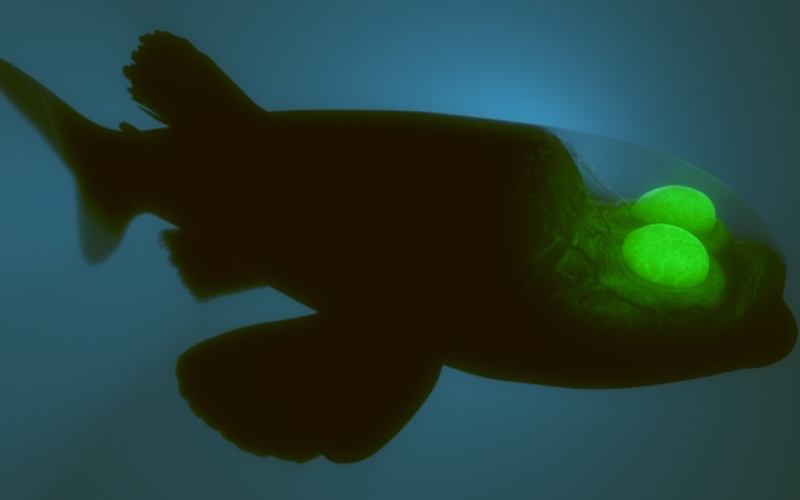
It is quite unique with a transparent, fluid-filled cover on its head, through which the lenses of its eyes can be seen.
Irrawaddy Dolphin
Irrawaddy Dolphin is an aquatic dolphin found in the Bay of Bengal and Southeast Asia. Quite sadly, there are very few individuals that still exist, making them very scarce. They are mostly found in the 118-mile stretch of the river between Cambodia and Laos.
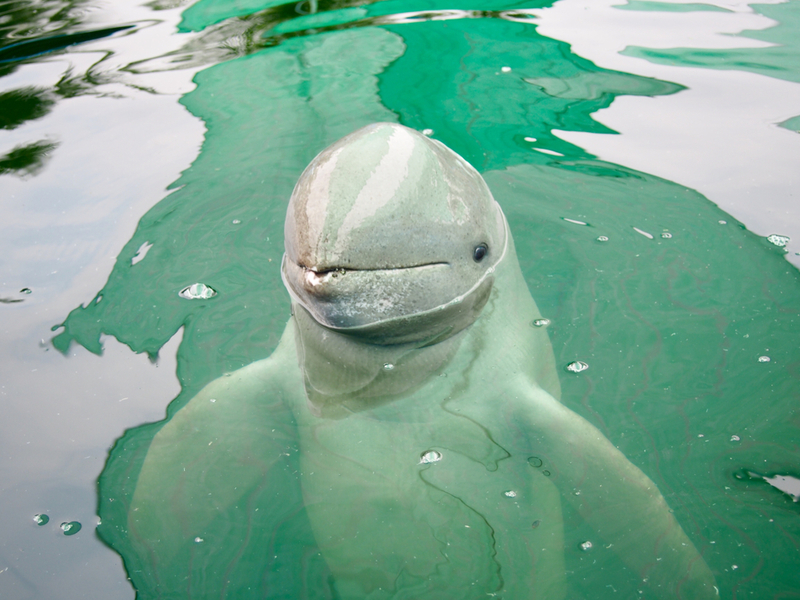
They feed principally on fish, which they find with sonar since they are nearly blind. Their most notable feature is a round head with no distinct beak.
Sunda Colugo
This adorable lemur is a Sunda Colugo or Sunda flying lemur. It's a species of colugo, native to Indonesia, Thailand, Malaysia, and Singapore. Sunda flying Lemurs are not only cute, but they are also really smart as they’re capable of learning new tasks that are often too complex for other primates.
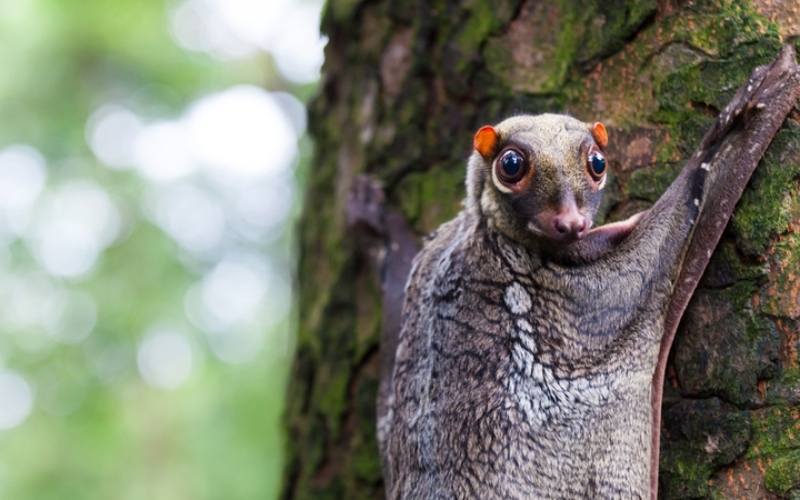
They actually don't fly but glide instead. Sunda Colugos are active at night and they feed on soft plant parts like young leaves, shoots, flowers, and fruits.
Blue Parrotfish
This glowing-blue fish can be found in shallow waters of the tropical and subtropical parts of the Caribbean Sea and the Atlantic Ocean. These Parrotfish are anemonefish: they can live for a while as male or female – but sometimes hormones kick in and cause them to change gender, now isn't that neat?
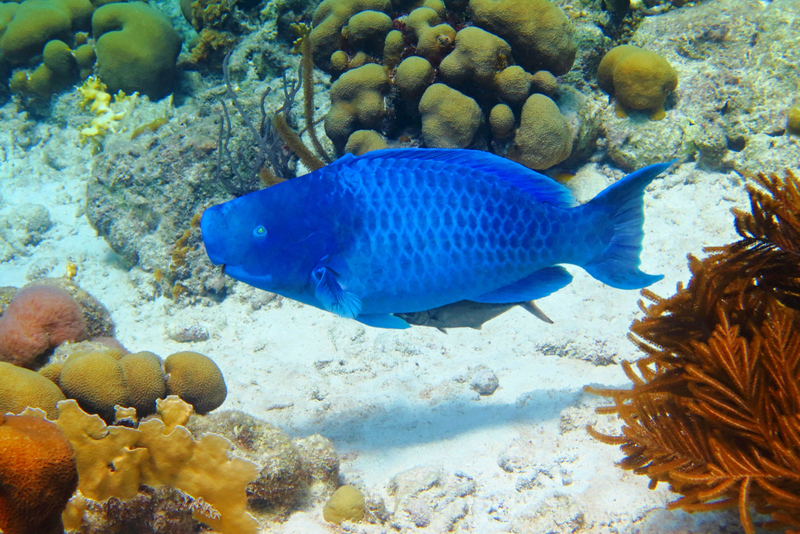
Most of their time is spent in search of food and they eat small organisms that reside within the sand as well as algae that they scrape off rocks.
Glass Frog
This fascinating frog can be found in Southern America and is a family of amphibians that exhibit an unusual peculiarity — transparent abdomens. Because their insides are visible through the skin, their common name is glass frogs.
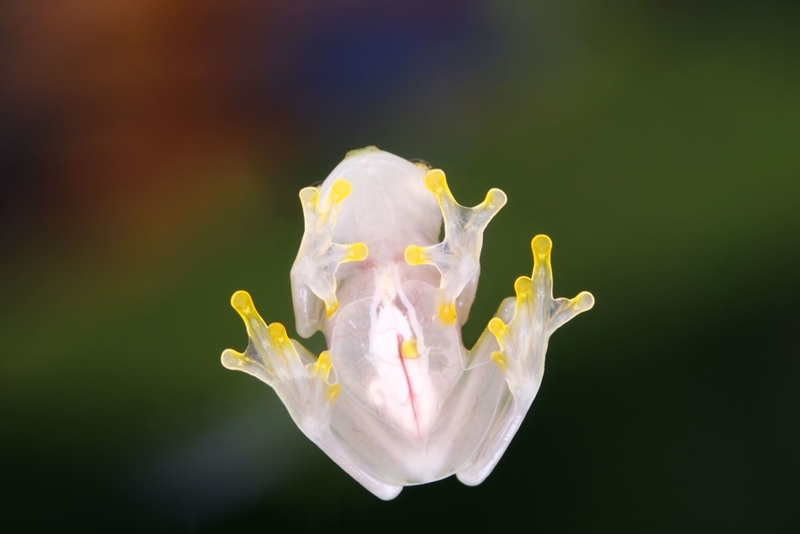
Glass frogs have incredible appetites, as such, they have a need to eat and are constantly in search of small insects.
Fossa
This is quite an interesting cat-like creature, or is it more like a squirrel? The fossa resides in Madagascar. Their classification has been controversial because physically it resembles a cat, while other traits suggest a relation to viverrids. Viverrids are medium-sized carnivores with longish frames and comparatively short legs.
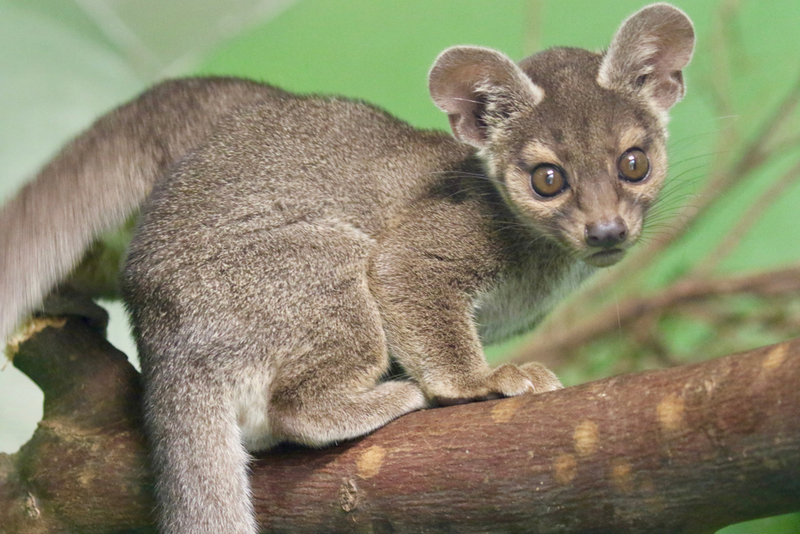
What is even more interesting, is that genetic study has shown that they are actually their own separate species.
Panda Ant
This looks like an ant designed by Tim Burton! But despite looking like an ant and being referred to as such, it is in fact a form of wingless wasp. They may well look like harmless little furballs, but these fierce little creatures have earned a reputation as “cow killers” and they should not be underestimated.
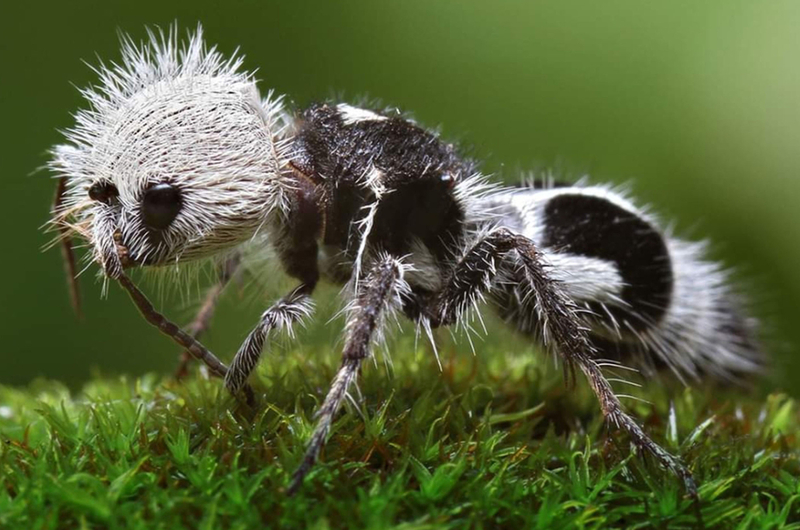
The females possess thicker fur but lack wings. The hairy panda ant can live up to 2 years.
Tufted Deer
These little deer are found in central China, the tufted deer is a small species of deer characterized by a raised tuft of black hair on its forehead and like most kinds of deer, fang-like canines for the males. These are actually tusk-like teeth they use to fight other males.
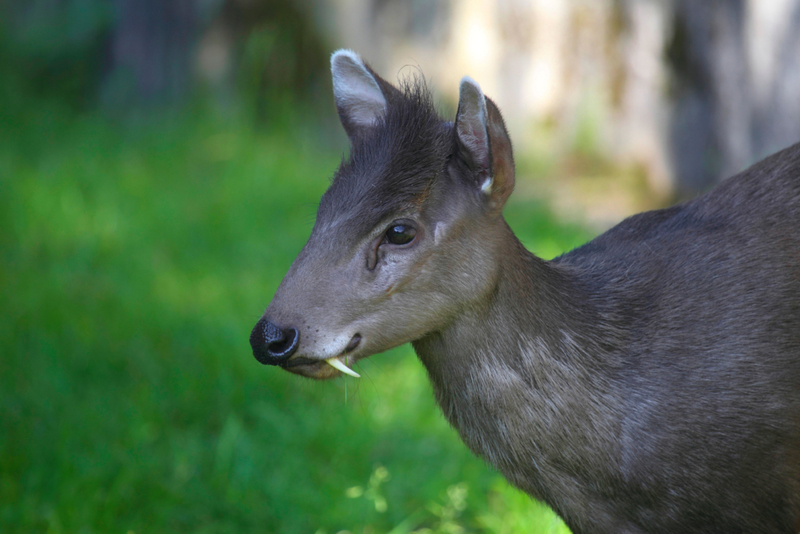
It is a timid, mainly solitary creature, and they sometimes live in pairs and enjoy living in areas with sheltered forests where they can find good cover.
Honduran White Bat
The Honduran white bat has characteristic white fur, with the tips of their individual hairs being gray as well as a peculiar leaf-shaped nose. Unfortunately, these charming little white bats are considered 'Near Threatened' on the International Union for Conservation of Nature scale.
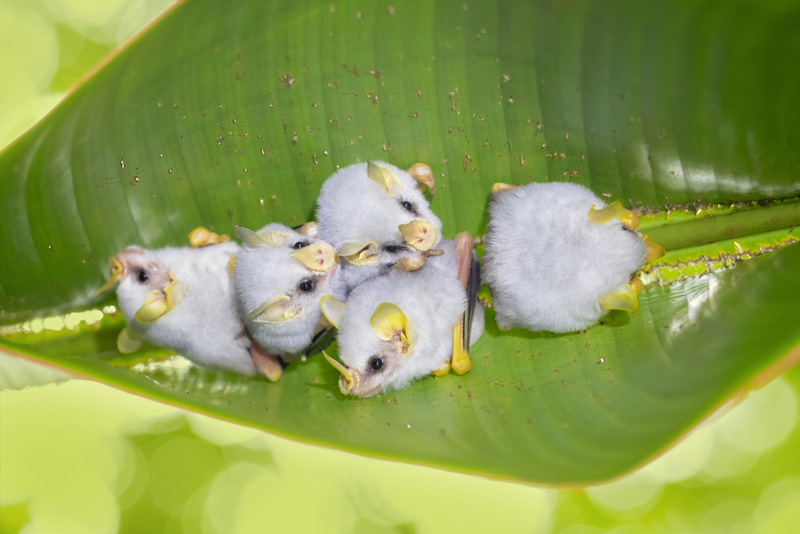
They dwell in leaf 'tents' that they create by cutting the side veins extending out from the midrib of large leaves.
Spiny Bush Viper
Atheris hispida is a venomous viper from Congo, Uganda, and Kenya. Spiny bush vipers favor rainforests that offer plenty of flowering shrubs and bushes. And because of their remarkably keeled dorsal scales, they are often called "rough-scaled bush viper" and "spiny bush viper".
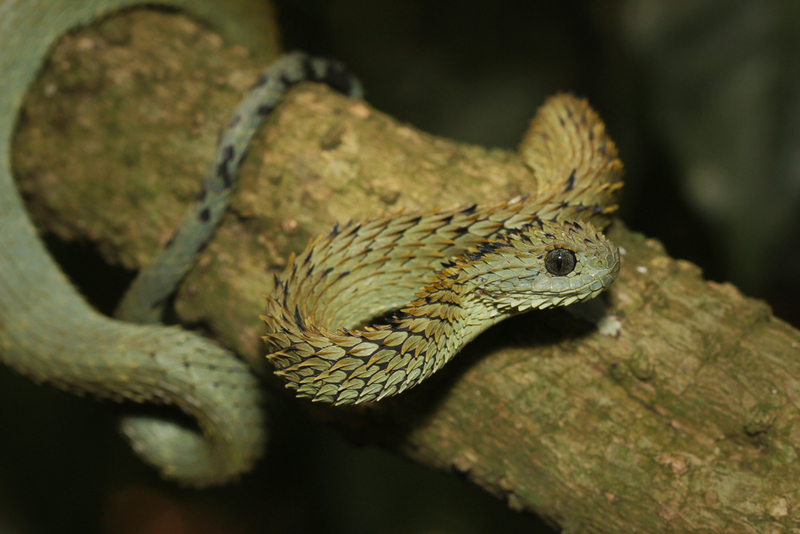
Spiny bush viper has strong venom which causes severe bleeding from internal organs. The amount and strength of the venom depend on each individual snake.
Leafy Seadragon
This charismatic species can be found along the southern and western coasts of Australia, this leafy seadragon has long leaflet protrusions coming from all over its body, which look amazing but also serves as camouflage.
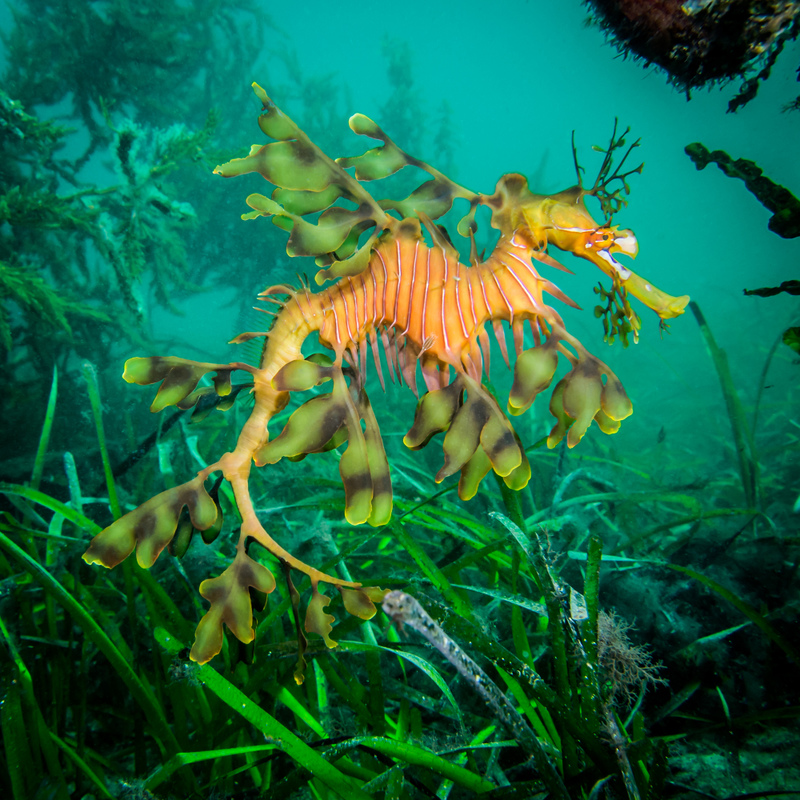
They don't have a specialized pouch characteristic of male seahorses. Instead, they carry their eggs under the tail.
Dik-Dik
Meet the miniature antelope that's so adorable, they named it twice! They are found in the bushlands of southern and eastern Africa, dik-dik is the name for four different species of small antelope.
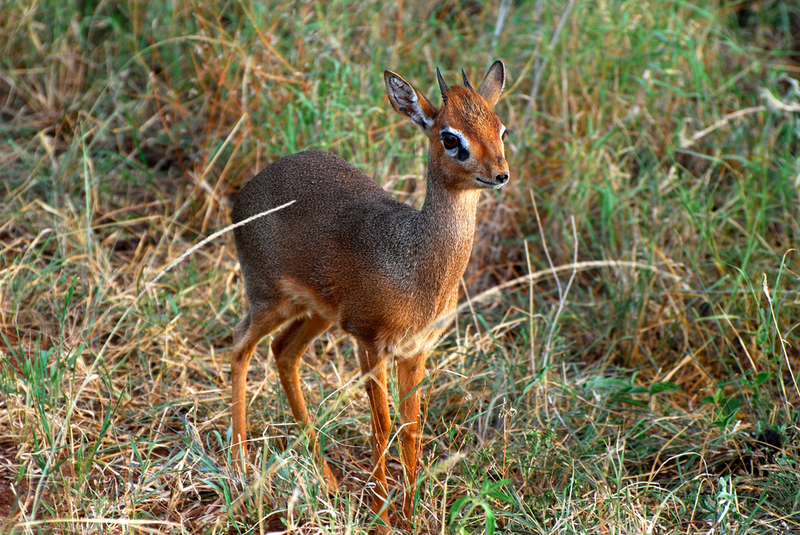
As herbivores, they are harmless and their name comes from the unique alarm call that the females commonly make, which sounds like a wheezing and whistling “dik-dik.”
Lilac-Breasted Roller
This colorful bird is widely spread within sub-Saharan Africa and the southern Arabian Peninsula, the lilac-breasted roller perches in high trees, and other lookout points where it can spot prey at ground level. They prefer more open areas, and for the most part, they stay away from treeless places.
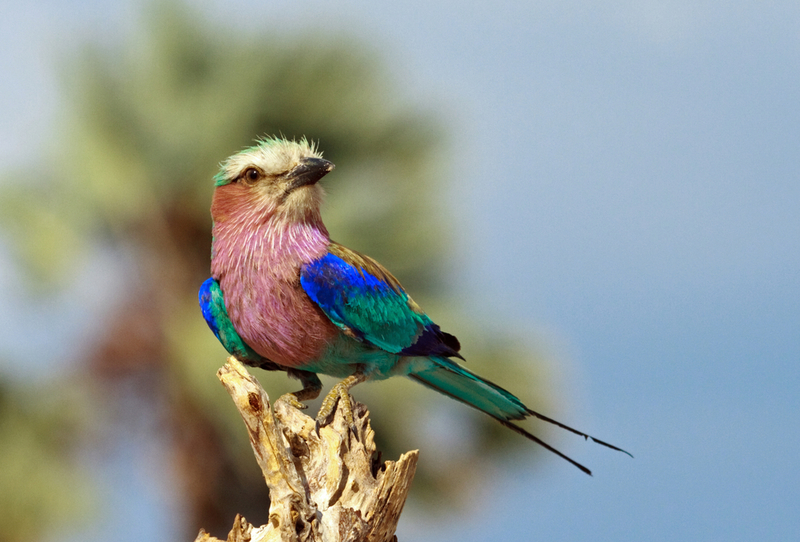
Their bright feathers are conspicuous with deep lilac breast feathers.
Satanic Leaf-Tailed Gecko
The Satanic leaf-tailed gecko is a type of gecko that is found on the island of Madagascar. With such an unusual name, we're all wondering where they got it from. This little gecko got his name from the Belgian biologist George Boulenger back in 1888.
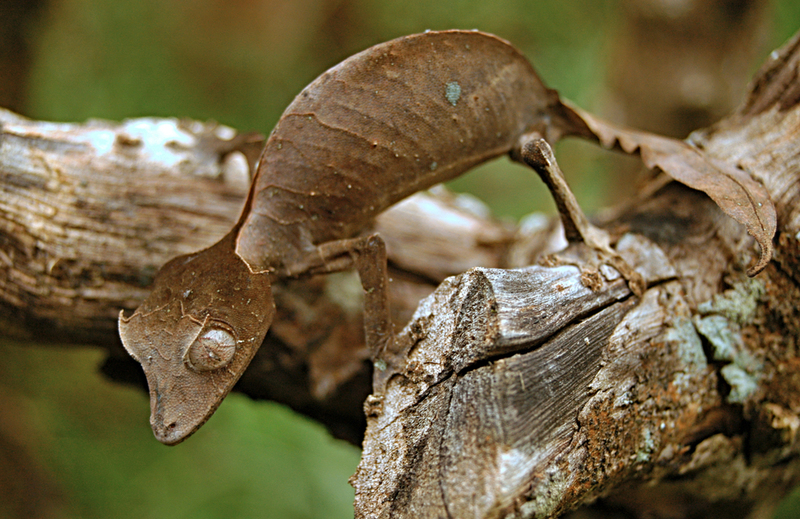
Their flattened tail appears to look like a leaf, helping the animal blend in within the environment.
Okapi
This incredibly rare mammal is native to Central Africa, mainly residing in the Democratic Republic of the Congo. Despite their zebra-like stripes, they are actually more closely related to giraffes.

The Okapi's chocolate coat is a reddish-brown shade, much in contrast with the white horizontal stripes and rings on the legs and white ankles.
Blobfish
The blobfish inhabits the deep waters off the coasts of Oceania, mostly mainland Australia, Tasmania, and New Zealand. It is primarily a gelatinous mass with a density slightly less than water, which allows it to float above the seafloor without using much energy on swimming.
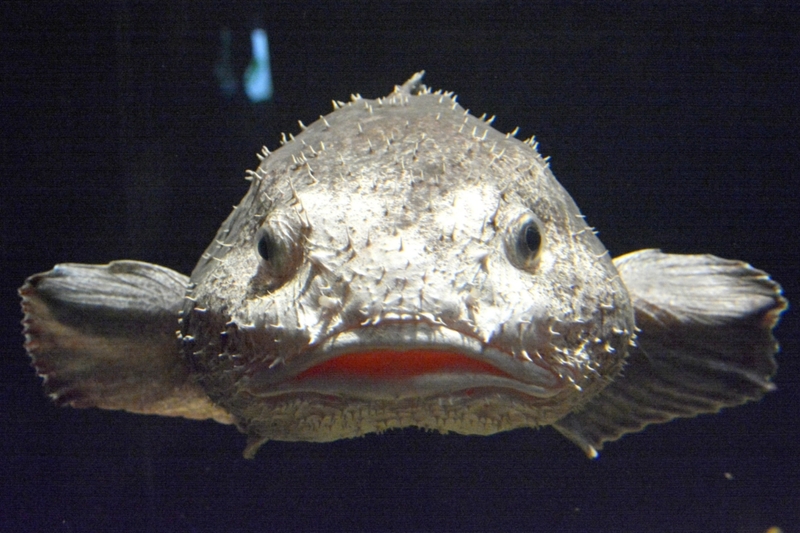
They only appear so droopy once they are taken out of the sea when pressure changes drastically.
Golden Tortoise Beetle
This lovely little fellow is native to the Americas. This species of beetle ranges in color from reddish-brown with little black spots to gold, and sometimes even metallic, earning them the nickname "gold bug".
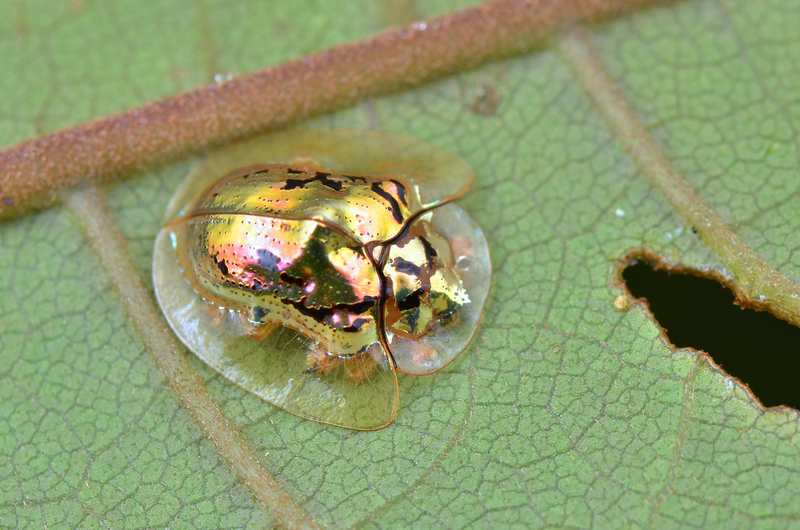
They tend to change color in different conditions, such as during times of disturbance, like when it is touched by a researcher.
Australian Peacock Spider
Australia has lots and lots of weird animals. Many of them are dangerous, too, though this colorful guy here doesn't seem to be very dangerous, since it's only five millimeters across. They're also just so fabulous.
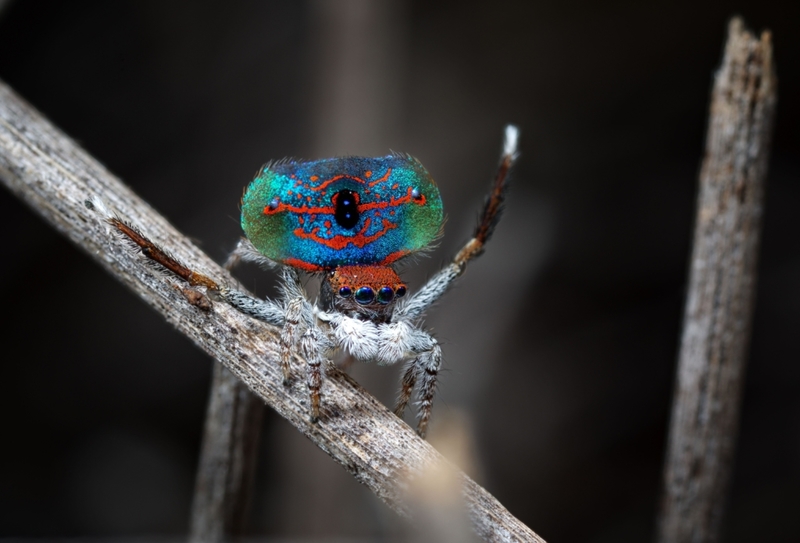
With the scientific name “Maratus Jactatus,” these spiders also have a moniker that's much more whimsical: Sparklemuffin, which comes from the researcher that discovered it, Madeline Girard. The males of these colorful spiders not only have a big, beautiful bodies to attract the ladies but they also coyly lift a leg off the ground to signal to the gals that they're ready to woo.
Maned Wolf
It resembles a fox, and it has 'wolf' in its name, but this canine creature is actually neither. It is, so far, the only species in the “Chrysocyon” genus. The name means “Golden Dog.” It's the largest canine in South America, standing thirty-five inches at the withers (which is the shoulder blades of an animal that walks on four legs).
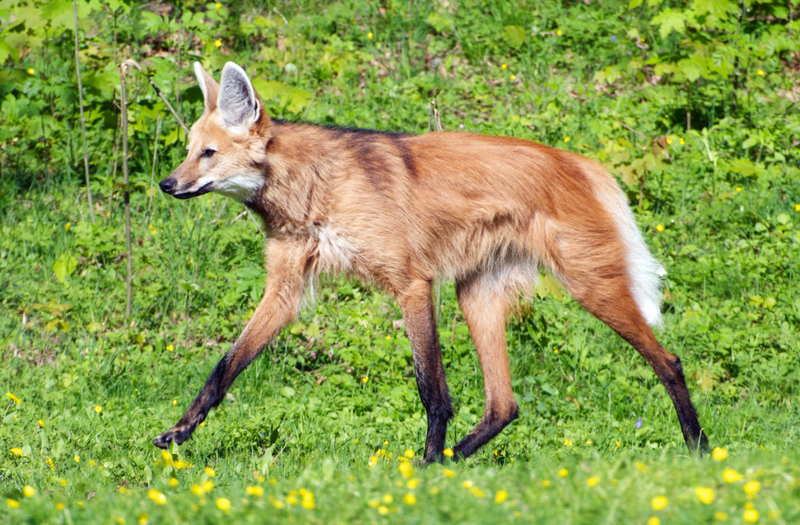
Living in the South American savanna, it's an important part of the environment, especially in seed dispersal. You see, the maned wolf eats fruit, and then...the seeds are...dispersed. Its loud call is called “roar-barking,” but it communicates mostly through scents. They're handsome fellas to be sure.
Patagonian Mara
Also known as the Patagonian cavy, Patagonian hare, or dillaby, the Patagonian mara is a herbivorous rodent from the mara species, which also includes capybaras, beavers, and porcupines.

Only found in Argentina, they can grow to a max size of around thirty inches. Their feet are compressed, turning them almost hoof-like in design, and the mara is easy to pick out thanks to the white underside as well as the orange flanks and chins. They are monogamous, though the couples often breed in large warrens with numerous other couples.
Naked Mole-Rat
If you're a fan of the classic Disney cartoon “Kim Possible,” then you're already plenty familiar with this one. For the rest of you: Introducing the naked mole rat, which manages to be both cute and incredibly disturbing.
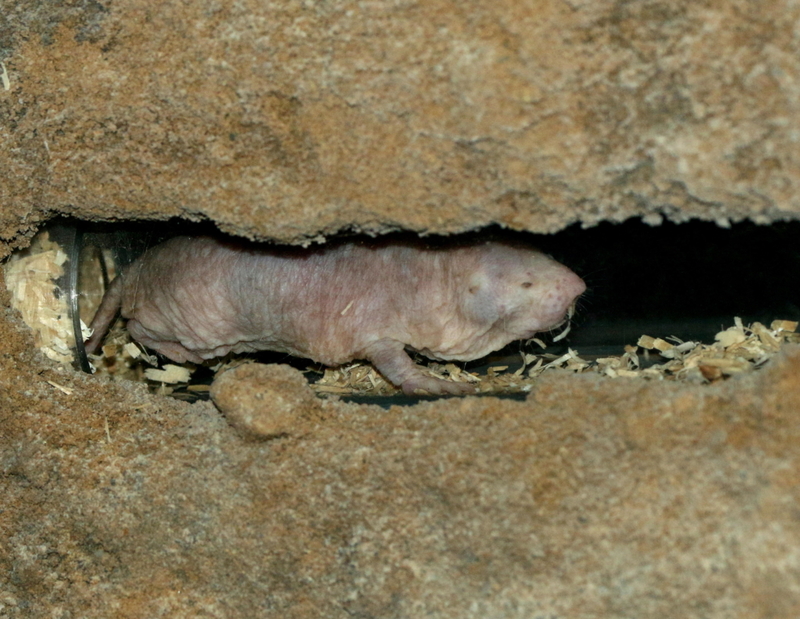
These burrowing rodents are the only species in the genus “Heterocephalus” in the rodent family. Its unusual physical traits (hairless, pain insensitivity, and strange method of regulating heat) make it singularly suited for the harsh East African environment. They, and the Damaraland mole-rat, are the only eusocial mammals in the world. Bees are also eusocial, so imagine a hive, but with naked mole rats.
The Gerenuk
Hey baby, what's up? This lean beast is called a Gerenuk, and it hails from the Horn of Africa, in the east. It's the sole member of the genus “Litocranius.” Also known as the giraffe gazelle, this mostly-proportional animal got its first description from naturalist Victor Brooke in 1879.

Characterized by its long, slender limbs, and its propensity to stand on its hind legs to reach those tasty, tasty high-up leaves. The species is sexually dimorphic, meaning the males and females look different, like peacocks and peahens. The biggest difference is the horns, which are only present in males. The horns are lyre-shaped and can reach up to eighteen feet in length.
Dugong
Ready to catch them all, but in the real world? This marine mammal is where the designers of Pokemon got the inspiration for the first-gen creature Dewgong. While the real version doesn't have a horn (and can't fire a jet of water hard enough to deal damage), they're still rare creatures.
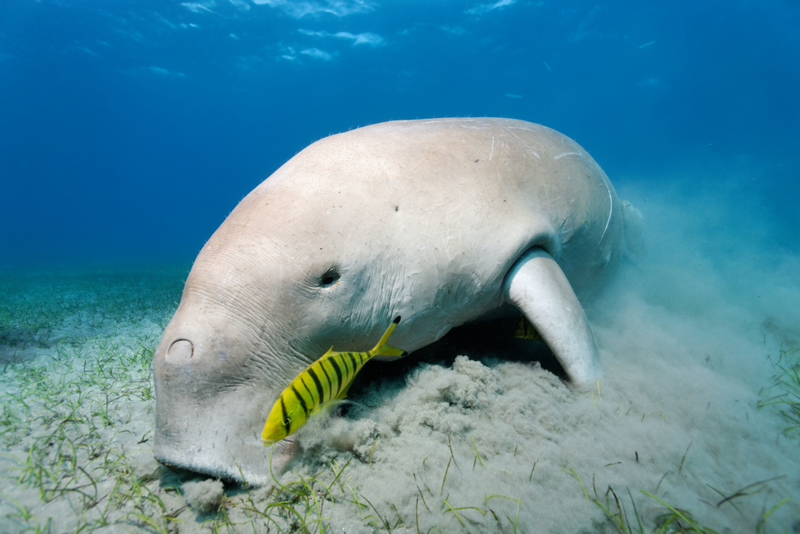
Like the rest of the animals in its order (“Sirenia”) it has no dorsal fin or hind limbs. It is easily distinguished by its fluked, dolphin-like tail, as well as its unique skull and teeth. The snout turns down sharply, which helps it feed on its favorite benthic seagrass. Unlike manatees, their molar teeth are simple and peg-like.
Babirusa
Babirusa, also known as deer pigs, hail from the Indonesian islands of Sulawesi, Togian, Sula, and Buru. This is actually a genus of animals with four different species that have small yet critical differences.
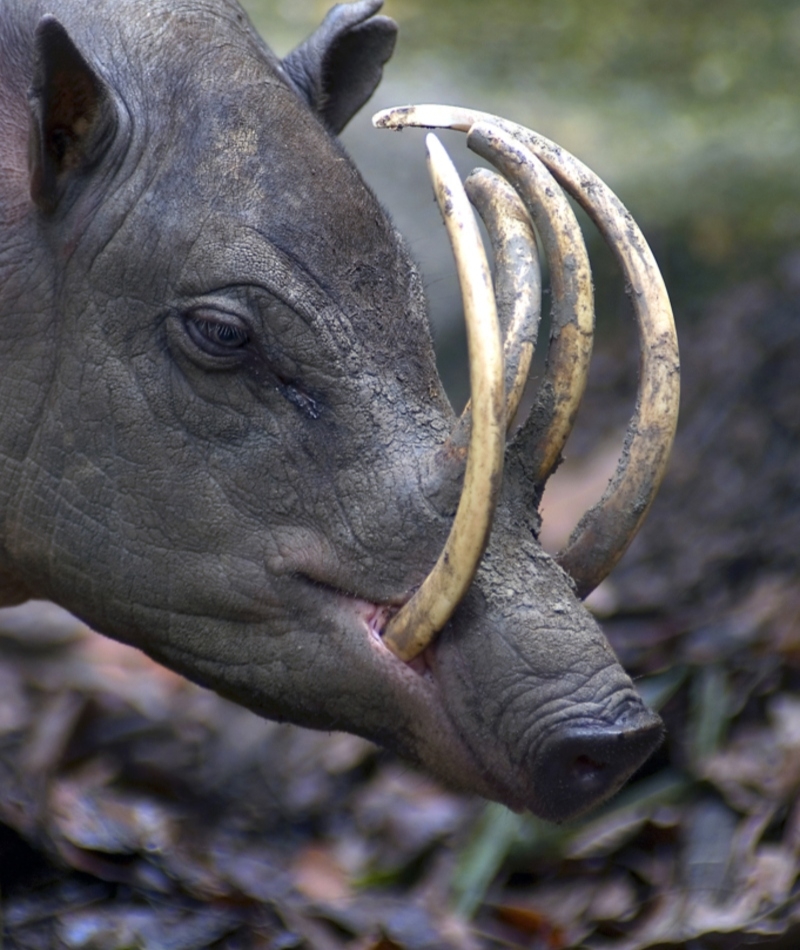
The differences include full-grown sizes, the amount of hair on the body, and the measurements of the skull and teeth. The most noticeable feature of this group of swine is their long, curved tusks. Not only do they develop from the sides of the mouth, like normal teeth, but the tusks from the upper mandible actually pierce the flesh, making them look like horns. Frequently, these tusks will grow so long as to loop back toward the eyes.
Lamprey
Well, it's been fun, everybody. We've seen plenty of cute creatures, and then there's this one. Lampreys are horrible, horrible monsters that aren't straight from your nightmares, but they'll be there soon.
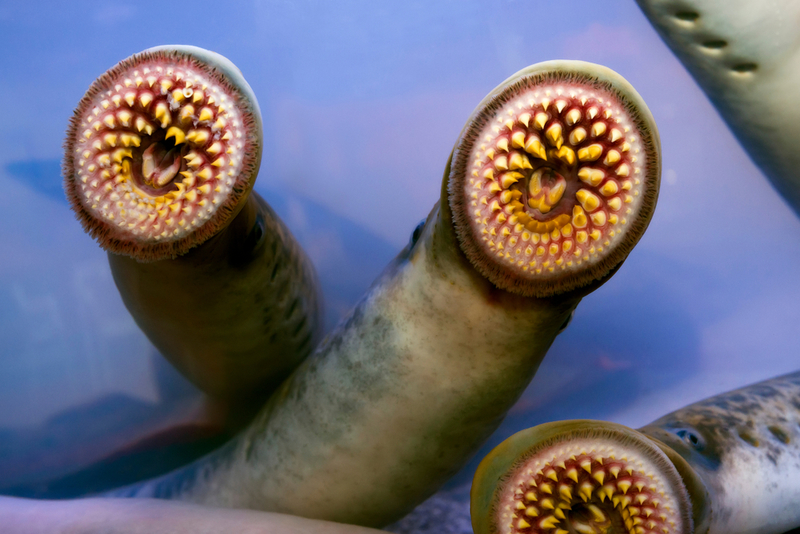
They are an ancient lineage of jawless fish of the order “Petromyzontiformes.” The name lamprey comes from the Latin word lampetra, meaning more-or-less “stone licker.” Lampreys include thirty-eight known living species, as well as five extinct versions. Most of the versions are parasitic carnivores — they feed by boring into the flesh of other fish to suck their blood. Yes, it's pretty distasteful. However, fewer than half of the species take this track.
Zebra Duiker
This little guy, found primarily in Liberia (along with the Ivory Coast, Sierra Leone, and occasionally Guinea), is a small antelope. Commonly referred to as a banded duiker or stripped-back duiker, it's thought to be one of the earliest members of the duiker family.
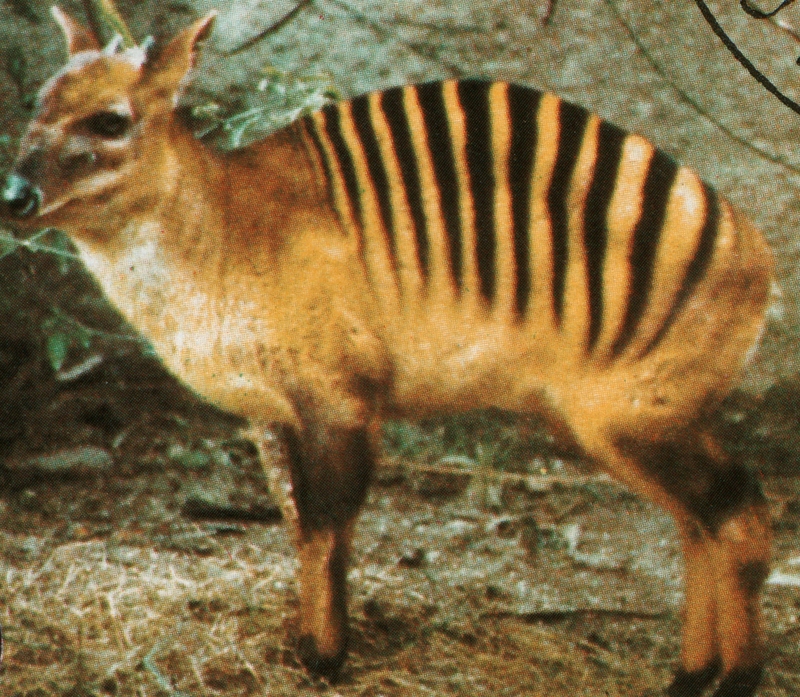
The big physical element of this creature is the black stripes that wrap around the top of its body, which is where the obvious name came from. These duikers are quite small compared to other members of the antelope family, usually only growing to about three feet in length, and weighing less than fifty pounds. Females are typically larger, and most likely to support longer gestation times.
Yeti Crab
These undersea creatures are prepared for the cold. Also known as yeti lobsters, yeti crabs are named after the legendary Yeti, a mythical creature thought to exist in the Himalayas. They exist in their own family, Kiwaidae, in the superfamily Chirostyloidea.

While it looks like they exist in cold climates, they're normally found around deep-sea hydrothermal vents and cold seeps — ocean floor areas where hydrogen sulfide, methane, and other fluids collect into pools. They are often warmer than normal water temps. The hairy, bristly appearance of their big forearms is actually for protection and to find food.
Cantor's Giant Soft-Shelled Turtle
Ask any third-grader the first thing that comes to their mind about turtles, and you're going to hear their big shells. However, there are some turtles that eschew the tradition, such as this pancake guy.
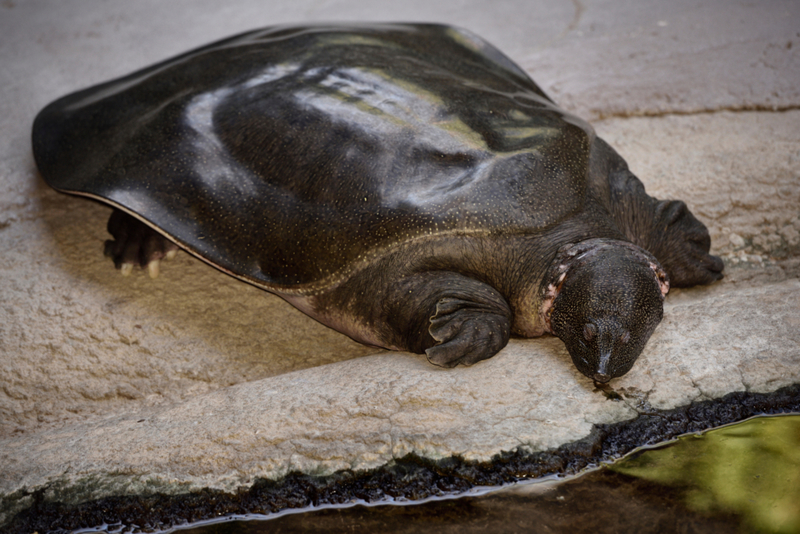
Consider some of the largest extant freshwater turtles — while some reports say they can grow as long as six feet, other reports dispute the fact. The length of the largest specimen was fifty-one inches, and the heaviest ever found was around five-hundred and fifty pounds. These turtles are, of all things, ambush predators, attacking crustaceans, mollusks, and fish, though they also snack on aquatic plants. It spends ninety-five percent of its life buried and motionless. Same, my dude.
Gobi Jerboa
The Gobi Jerboa, as the name suggests, comes to us from the Gobi desert in China and Mongolia. This species was only discovered a hundred years ago by Glover Morrill Allen.

Researchers are unsure how many members of this species exist, though due to the frequency of encountering them, the conservation status has them placed at the “least concerned” status. With long ears and spindly, jumping legs, the movement of this creature is quick and light. The tail (usually much longer than the body of the animal) often drags on the ground.
Goblin Shark
Sometimes called a “living fossil,” the goblin shark is the only extant representative of the family Mitsukurinidae, which goes back some 125 million years.

Goblin sharks — we're sure you can come up with your own great name for them — are all around the world, always at depths greater than a hundred meters, with adults being even deeper. While the goblin shark poses no danger to humans, going swimming at night and having this thing brush past you is going to warm up the water around you pretty quickly.
Umbonia Spinosa
It's a little hard to tell what this animal actually is, but look close enough and you'll see a bug down there. These creatures are also called thorn bugs and are closely related to cicadas, those noisy guys in the trees.

They use their beaks to pierce plant stems and suck out the tasty sap. Their defining characteristic is the large and colorful dorsal horn. The horn gradually tapers to a point, giving it its thorn name. The indigenous people of South America consider the juvenile form of this bug edible since their spines are still soft after molting.
Hummingbird Hawk-Moth
What happens when you jam three flying animals together into one body? You get the hummingbird hawk-moth. So, which one is this? It turns out it's actually a moth, but just like a hummingbird it feeds on flowers and makes a similar humming sound. It also looks similar to a hummingbird. We're unsure why they decided to add “hawk” to the name. Those scientists are a kooky bunch.

The hummingbird hawk-moth can be found in a great swathe of the northern hemisphere aside from the Americas, from Portugal to Japan, as far south as the equator, and as far north as the Arctic Circle. It's also quite good at recognizing colors.
Mantis Shrimp
The mantis shrimp is one of the most unique creatures you're going to see on this list. They're known as sea locusts, prawn killers, and “thumb splitters.” But why, you might ask.
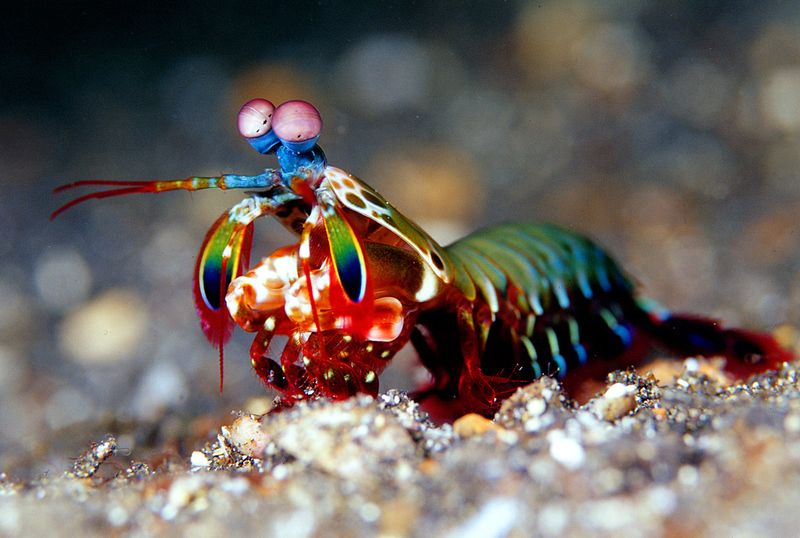
Here's one of the most interesting animal facts you could learn: the mantis shrimp is a predator in tropical and subtropical waters, hunting with only its fists. They're able to strike underwater with such speed and power — an acceleration of more than ten thousand times the force of gravity — that the water they're punching through creates special cavitation bubbles. The bubbles collapse around their prey, creating a force of fifteen hundred newtons.
Pacu Fish
In most ways, the pacu fish is just like most other fishes. In most ways. As you can see from the picture, the pacu fish has a healthy set of chompers that look uncannily like human teeth.

Fishermen from Papua New Guinea, where the fish is found, had to take special precautions to protect...sensitive areas from this fish, which can be aggressive. The pacu fish is related to the piranha, another omnivorous fish with teeth. However, while the piranha has pointed, razor-sharp teeth, the pacu feed mainly on plant material, meaning their teeth are made more for grinding and chewing, not tearing. Pacu can grow up to almost four feet long.
Giant Isopod
Isopods, for the most part, don't grow to be so large. Something that, as you look at the picture, you're probably happy to hear. Giant isopods are one of the almost twenty species of large isopods in the genus Bathynomus.
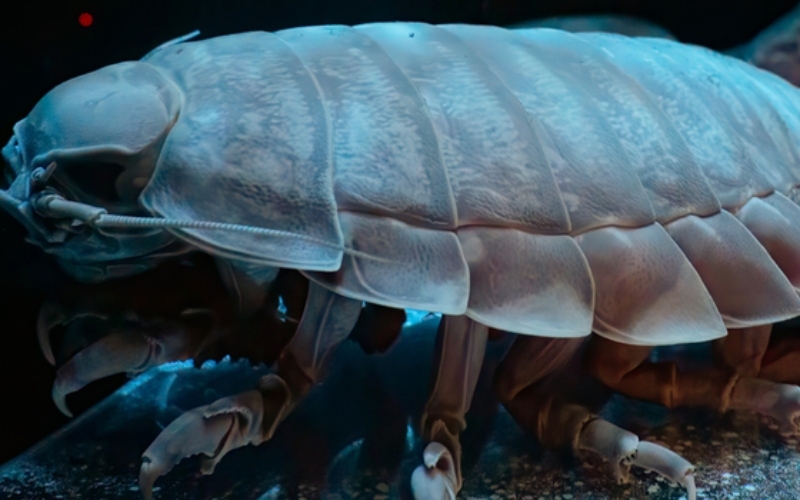
Found mostly in the cold, deep waters of the Atlantic, Pacific, and Indian Oceans, their large size is due to something called deep-sea gigantism. It is the tendency for creatures of the deep sea to grow much larger than similar species that reside in shallower water.
Raccoon Dog
Don't let this cute exterior fool you. While both dogs and raccoons are pretty used to living around humans, this creature is 100% a wild animal. Raccoon dogs live in the forests of East Asia and East Europe, where the locals call them by different names, such as neoguri, tanuki, or mangut.
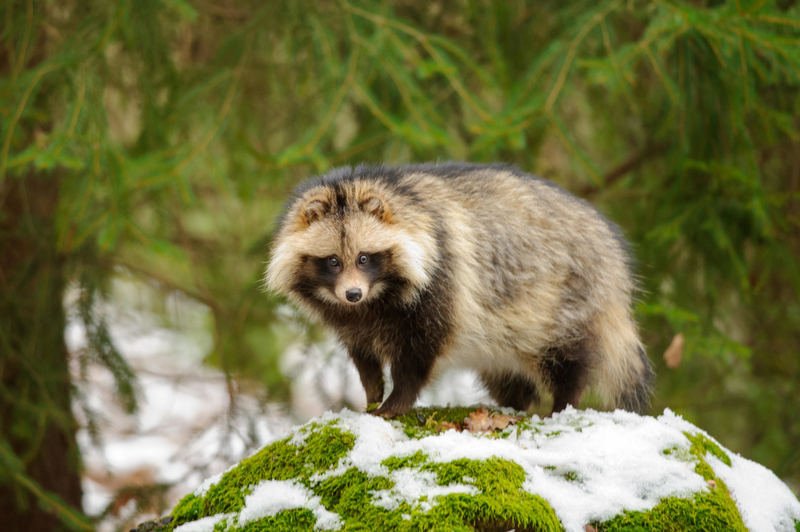
These raccoon-looking wild dogs aren't usually seen outside of their lairs during the daytime. Nocturnal by nature, they prefer to wander around and hunt after the sun goes down.
Shoebill
This large stork-like bird gets its name from the shape of its beak. It sort of looks like a shoe. While it was known to ancient communities in Egypt and Arabia, the bird wasn't actually classified until the nineteenth century, by John Gould.
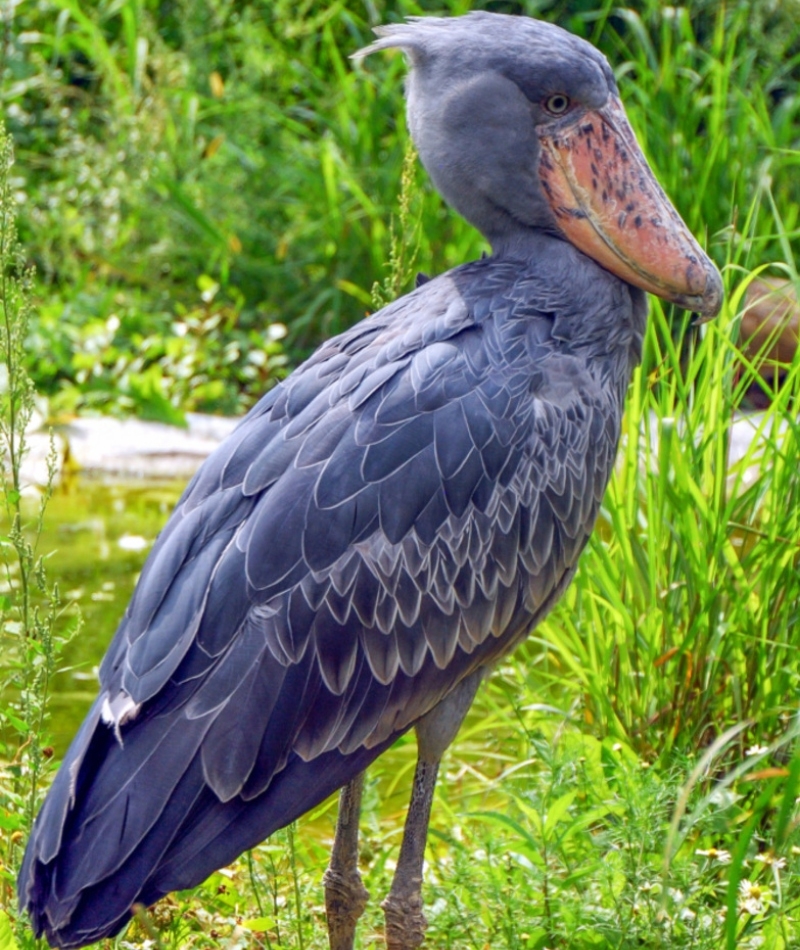
The bird's best-known feature is its distinctive bill, which they use to catch and hold on to large, slippery fish that they enjoy eating. The birds will stand in the water, motionless until their prey gets close enough. When the time is right, they will dive, or just fall, into the water with their bills open, ready to scoop up some dinner.